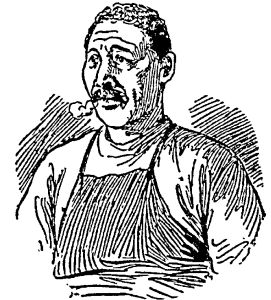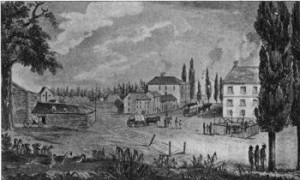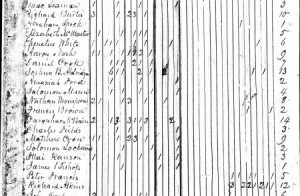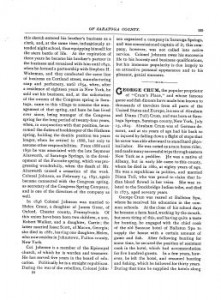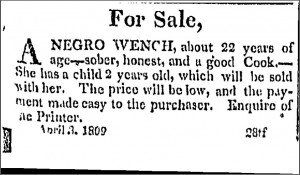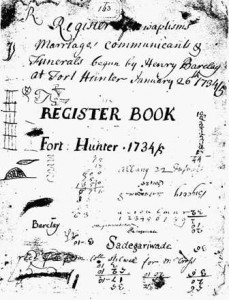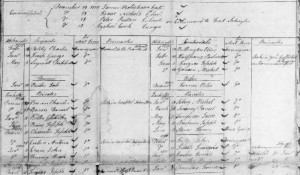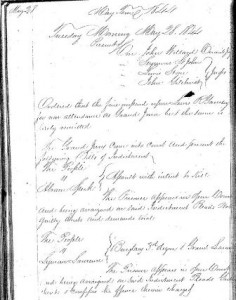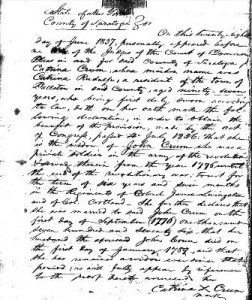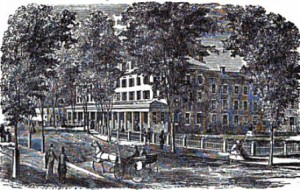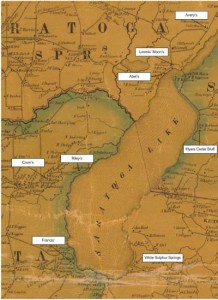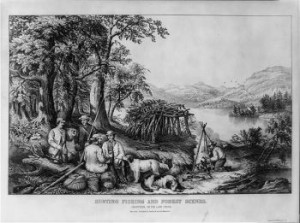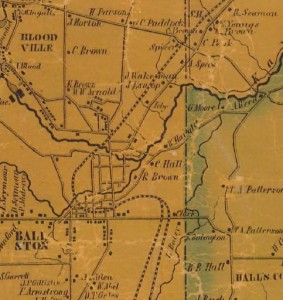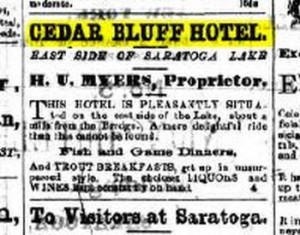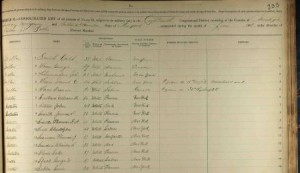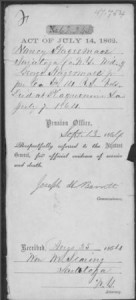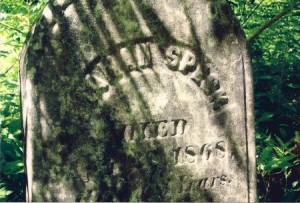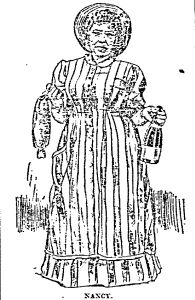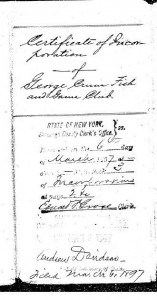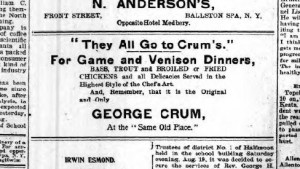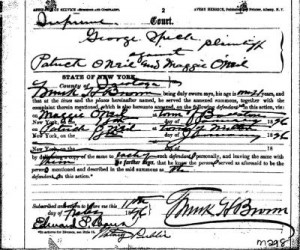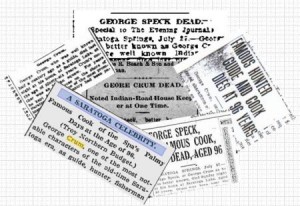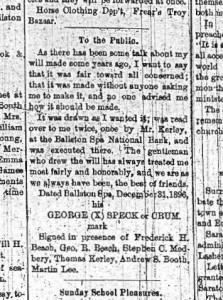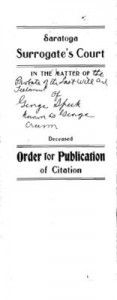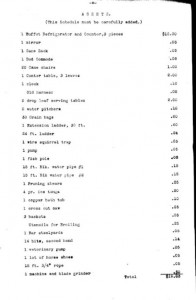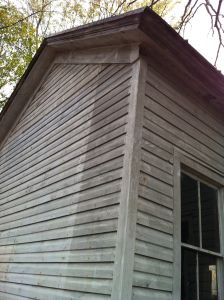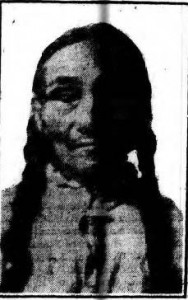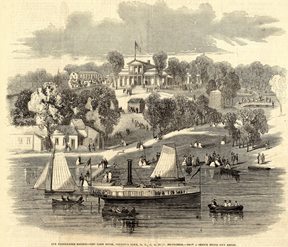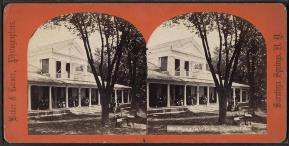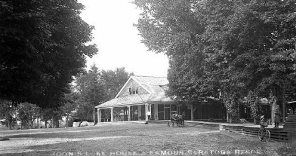INTRODUCTION
Let me begin with something that will probably disappoint most people who read this, I don’t believe that George Crum invented the potato chip. For a full discussion of that topic please see “Saratoga Springs, New York: Birthplace of the Potato Chip” and “Saratoga Potato Chip Stories: Traditions, Myths, and Legends.”
What George Crum was able to do was overcome a number of obstacles to become arguably one of the best known cooks in the country, in his own restaurant, in a community famous for its excesses at both the dining room table and gambling table. In 19th century America, this descendent of African, Native American and European ancestors, raised in poverty, unable to read or write, struggled for everything he gained. By the time he died in 1914 he had hosted Presidents, Senators, and the rich and famous at the restaurant he built, and his skills as a hunter fisherman and guide were almost as prized as his prowess as a chef. His story is interesting not only because of his unexpected success, but also because we know enough about his life to be able to see some of the highs and the lows he experienced. It also gives us a chance to see some details of the life of a man who wasn’t always famous and was never white. Too often the only time newspapers and histories written in the 19th century discussed a person of color the passage only dealt with a funny story, an eccentricity, or something that painted a picture of a character. There are articles like this about George Crum, but fortunately there is also coverage of his accomplishments. These materials when combined with information from official records create an unusually rich, although not complete story of his life. This is especially remarkable considering he was unable to leave a written record of what he thought and what he experienced.
GEORGE CRUM
George was born on July 15, 1824 or 1825, in Saratoga County, New York. Sources not only disagree on the year of his birth, but also on his birthplace, although no one has suggested anywhere outside of Saratoga County, New York. [1] While it appears that George grew up in Ballston Spa, it’s possible that he was actually born in Saratoga Springs.[2] Growing up, George and his parents, Abraham Crum and Diana Tull were part of a small community of people of color in Ballston Spa.[3] I purposely have used the term people of color because using a term like black or African American may not be accurate or tell the entire story. It is very likely that at least some of the families in Ballston Spa that were identified by census takers as “other free persons” may have had ancestors of not only of African descent, but also European and possibly Native American. There is evidence to suggest George’s ancestors included people from Africa, Europe, and America before European discovery.[4]
By the 1820s there were few slaves living in Ballston Spa, but there is a very good chance some of these residents were former slaves. Unfortunately freedom did not mean that these families, identified as other free persons, were treated the same as everyone else. Whatever their ancestry these residents of Ballston Spa, including the Crums, were viewed by white society as not white and society dealt with them using a different set of rules and laws.
Unfortunately we don’t even know how they viewed themselves or how they defined their community or communities. Many years later it is hard to know if these “other free persons” were one cohesive community or if there were divisions in how they saw and treated each other.
George Crum was one of only a few members of this community that had a chance to leave a record of how he viewed himself. Unfortunately he may not have been able to be completely honest; his ability to earn a living, his standing in the community and his pride may have influenced his choice of what was recorded. George’s chance came in his late 60s when he was successful enough to have a biographical sketch included in a history of Saratoga County. In order to have a biographical sketch included the book you paid for the privilege and in exchange you were able to control what was printed about you. What makes this kind of profile particularly interesting is that it is very likely that George provided the information to the book’s writers.[5]
George’s profile claimed that his father Abraham was of German descent and Diana, his mother, was “proud to claim that Indian blood flowed in her veins. “ He made no mention of anyone being of African descent on either side, and only acknowledged Native American roots on his mother’s side. However Diana is not identified as an Indian in any census, but is identified as both mulatto and black, suggesting that although she may have had Native American ancestors she also had African origins. [6] There are also records to suggest that Abraham had more than just German ancestors. Over his life Abraham was identified as a free colored person, black, mulatto and colored, and at least one account suggested that he may also have had some Native American ancestors.[7] We don’t know why George chose to ignore what seem to very likely be African ancestors. It is possible that by emphasizing Diana’s Native American ancestry and Abraham’s white ancestry George may have thought that his Native American heritage was an asset in his guiding and hunting business.
George was not the only member of his family who may have wanted to distance themselves from that portion of their past, his nephew George W. Francis took enough offense to a writer identifying his father Peter Francis as mulatto instead of an Indian that he wrote a letter to the newspaper to correct them.[8]
The information we have about George’s ancestry is a mix of conclusions made by people who identified George and his family based on how he looked and on the people around him. This happened in census and other official records and in newspaper stories printed during his lifetime. The words people used to describe him are very subjective, but may be useful when looked at over multiple years. For example one of the terms used to identify George was mulatto. When this term was used in the census it was meant to indicate anyone with any African ancestry combined with any other ancestry. When included in a description of a person it could also mean someone of African descent with light skin. A person described as a mulatto could have been of African descent, African and European descent, African and Native American descent, or even African, European, and Native American descent.
People of Native American descent were only supposed to be included in early censuses if they were living in or near white communities and not a part of tribe. In Federal censuses before 1870 it wasn’t even clear how an enumerator was supposed to identify these Indians, since that was not an option in the color column for Indian. Enumerators could have listed them as white, possibly mulatto or not at all.
All of this means that it is challenging to make any definitive conclusions about someone’s ancestry using the records we have at our disposal. To give a sense of how subjective ancestry may have been George was identified using the following terms during his life, Indian, half-breed, half Indian half negro, free colored person, mulatto, black, and colored.[9]
For George and other people of color these labels, whether they were accurate or not, carried weight. Applying those terms could affect how he and his family were treated, his civil rights, and his ability to earn a living. For his parents and grandparents it carried even more weight, it could mean the difference between enslavement and freedom.
Many people think that slavery existed only in the south, but people were enslaved in New York, including in Ballston Spa, Saratoga Springs, Albany, Schenectady, and communities in the Mohawk Valley, the areas where George’s family may have had its origins. While some of the Crums were free persons of color even before the Revolutionary War, not everyone was so fortunate; New Yorkers did not actually make an effort to end slavery in the state until 1799 and this gradual manumission was not completed until 1827. While I have not been able to document any enslaved ancestors in George’s family, it seems likely that at least some of George’s ancestors of African descent and even possibly his Native American ancestors were once slaves.
FAMILY ORIGINS
Tracing George’s ancestors has proven challenging but I have been able to make some connections back to 1776 and it is possible that some of his ancestors lived in New York State as early as the 17th century. [10] George’s paternal grandfather John Crum served in the Revolutionary War, enlisting while living in the Mohawk Valley on New York’s frontier.[11] Unfortunately his life before 1776 remains a mystery and I haven’t been able to discover anything about his parents.
While it seems that George chose to use the name Speck in most of his formal or legal transactions he eventually became better known as George Crum. His grandfather used the name Crum or Crumb, but may not have used the name Speck.
Tracing the origins of a last name for a person of a color is particularly daunting. The names could have been passed from father to son or daughter, but it is also possible that a surname had been assigned or selected only recently. The choice of last name Crum or Speck, may have not always have been up to the family member; those who created the records may have made the choice for them. In the case of persons of color records often contained only first names and a descriptive phrase such as slave, free, Negro or Indian. For people with Native American ancestry surnames may have started to be used when they became Christians and for other persons of color when they gained freedom. It’s possible that the name Speck or Crum whether given or chosen came from the name of a slave owner, but it is also possible it was a nickname or a creation of some kind. There is also no way to know if Crum was just a variation of Speck or if Speck was a variation of Crum although it is easy to see the similarities in the name.
While there is no record of John Crum ever using the name Speck, George, his father Abraham, and George’s son Richard all used the name Crum as well as Speck during their lifetimes and it is possible that John Crum did that as well, it just hasn’t been captured in a surviving record.[12]

Letter from Nicholas Speck, Symon Speck’s son. From the collections of the Schenectady County Historical Society, Grems-Doolittle Library.
In my research I have discovered a number of families who are identified as persons of color in the records with the last name Speck, but almost no one with the last name Crum. I believe that John Crum was somehow related to the Speck’s who lived in Schenectady, New York, but have not been able to find that link. Several generations of Specks, both free and enslaved lived in Schenectady as early as 1705 and appear to be descended from Symon Speck and Susanna Thomassen. Their descendants remained in the area until the 1820s, but then seem to disappear with the exception possibly of George’s line.[13]
Hoping to find something about the origin of the Crum or Speck family I have researched families of European descent to search for any kind of connection, but I have not been able to discover anything. There were families of Dutch ancestry with the name Crum and families of German ancestry with the name Specht or Speck, but there are no obvious connections to John Crum.[14] I have not found any white Speck families in Saratoga, Schenectady, Albany, and Montgomery counties before the Revolutionary War and only one Crum, in that case Crom. I haven’t been able to find information about him other than he was a witness at the baptism of one of Symon Speck’s children.[15] Sanders, the last name of the man who once owned Symon Speck, the first member of the Speck family I have found, provides no clues to the origin of the Crum or Speck either.[16]
Symon Speck may have lived in Schenectady, but John Crum’s first records appear further to the West in the Mohawk River Valley. Before the Revolutionary War settlers had pushed from Albany and Schenectady West along the Mohawk River Valley and it is possible that some of Symon’s descendents were among them.
John Crum, George’s grandfather, was born about 1744, but we don’t know where.[17] In the late 1730s and early 1740s some Specks, very likely Symon Speck’s grandchildren, were baptized at a chapel at Fort Hunter, a military installation approximately twenty miles west of Schenectady. There is no mention of a John Speck or a John Crum, but it is possible that one of the children baptized there later used the name John or that his baptism either never occurred there or was just not recorded.[18]
The first time John Crum’s name appears in any record I have been able to find is on the muster roll of a Colonial militia unit in 1776.[19] By the 1770s there were settlements at Caughnawaga, now Fonda, Stone Arabia, and Herkimer on the North side of the river further west of Fort Hunter and Schenectady. Since militia units served in the region where they were raised, John was likely living in this area before he was mustered into the Rangers. John Crum served in Christopher Gettman’s Ranger Company of the Tryon County militia. Tryon County, was later renamed Montgomery County and covered a larger area than today’s Montgomery County, but an analysis of where the other rangers in his company lived suggests that his home was on the North side of the River, likely between Caughnawaga, now Fonda, and Stone Arabia.[20]

Affidavit from Abraham Van Horne regarding the marriage record of John Crum and Catrina Rudulp, from Catrina Crum’s pension application.
A few months after his name appeared on the militia rolls, in September 1776, John Crum married Catrina Rudulp, in the Reformed Protestant Dutch Church of Caughnawaga.[21] What is somewhat puzzling is that there is nothing in the record to indicate that either John or Catrina were persons of color. This could mean that John and Catrina were not persons of color or that the Church did not add that fact to their record. There are no indications that any of the marriages in the record involved people of color; however baptisms recorded at the same time do record that information. I believe, based on later census records, along with records relating to their descendants, that both John and Catrina were in fact people of color.[22] The fact that the marriage was performed at all and there was no mention of an owner in the record strongly suggests that they were free at the time of their marriage, although doesn’t necessarily mean that they had been born that way. The marriage occurred relatively late in their lives, John was approximately 32 years old and Catrina was about 36, which could indicated that it was a second marriage for one or both or that they may have waited to be married, perhaps waiting until they were free. Unfortunately I haven’t been able to discover anything about Catrina Rudulp Crum’s life before her marriage. I have not been able to find any other Rudulps or Rudolphs in area suggesting that Catrina could have been the first person in the family to use the last name Rudulp.
After a few months serving in the Ranger Company, and just days after his marriage, John joined the Continental Army at Johnstown, a community about four miles north of where John and Catrina were married.[23] During his service in Colonel James Livingston’s Regiment he fought at the Battle of Saratoga, and when stationed near West Point, his unit fired on the British Ship Vulture. This led to the capture of Major John Andre and the discovery of Benedict Arnold’s treason. [24] When Livingston’s regiment was disbanded, John Crum transferred to the 2nd New York and was present at Cornwallis’ surrender at the Battle of Yorktown.[25] Frost bite ended his service and forced his discharge from the army in 1782 as the War was coming to an end.[26] Unfortunately none of the records that would have indicated John’s ancestry have survived for his regiments. Only one type of record, the descriptive rolls contained physical information, most of the records do not indicate ancestry or color and because persons of color served in the same units and were paid the same as white soldiers, there are no clues in the surviving documents.
The Mohawk Valley frontier, where John and Catrina lived, had been devastated during the War and many people were either forced or chose to move back from the frontier to Schenectady or Albany. We don’t know if Catrina remained on the frontier during the War, moved to the relative safety of Albany or Schenectady, or travelled with the Army working in the camps doing laundry or cooking. Wherever Catrina lived during the War the Crums were among those to live in Albany after the War as early as 1784. [27] We don’t know how many children John and Catrina may have had, there are traces of two possibly three children, but only one baptism record survives. I have not been able to locate a record for Abraham, George’s father, who seems to have been born about 1789, but another, John Rudolff Crum was baptized in 1792 at the First Presbyterian Church in Albany.[28] This baptism records seems to be the only record he left, I haven’t been able to find any trace of John Rudolff Crum.
CATRINA CRUM
Catrina Crum recalled many years later that her husband died on January 1, 1789, but several other records suggest that he may have survived until the early 1790s. John Rudolph Crum’s baptism record specifically names him as the father, suggesting that he was alive until at least August of 1791.[29] After John Rudulff Crum’s baptism in 1792, the family disappears from records for the next two decades. There could be a number of explanations for this; it is possible they were missed in the 1800 and 1810 census. Or since both the 1800 and 1810 census only listed the head of a household they could have lived with other family members or friends, or worked as live- in servants in a white household.
About 1810 Catrina, and likely her son Abraham, moved to Ballston Spa, a Village about 30 miles north of Albany.[30] They weren’t the only people of color to move to Ballston Spa during that time period and it’s possible they all may have been attracted by the potential of employment.[31] Ballston Spa, even before Saratoga Springs, was a destination for wealthy visitors who sought to get out of northern cities in summer and to escape the heat of the south while sampling mineral waters that were widely believed to not only keep you healthy but cure disease. Only the very wealthiest Americans could visit these new resorts in Ballston Spa and Saratoga Springs, because they not only had the money to travel, they had the time. The Hotels built for these visitors required extensive staffs to serve their guests as they tried to keep them as comfortable and well fed as possible. These service jobs were some of the only ones that were open to people of color. Even those with a skill or an education found jobs they were qualified closed off to them because of discrimination. Catrina, although already in her 70s might have found work in a hotel kitchen or as a laundress, but the only job we know she had was not related to the Hotels. Catrina worked in the house of Thomas Palmer, an attorney, judge, and Saratoga County Clerk, probably taking care of his children. [32]
ABRAHAM CRUM
Abraham could possibly have found work as a waiter, a porter, or a hostler, but his options may have been more limited than other men of color. Abraham injured his back as a child and it left him disfigured and unable to perform some physically demanding jobs.[33] The injury apparently didn’t prevent him from racing horses at some point in his life, something that George Crum suggested he did well. He also worked as a laborer and a peddler, but his work history seems to have been somewhat sporadic.[34]
Abraham started a family with Diana Tull in the early 1820s. Unfortunately Diana’s background before her life with Abraham, like her mother in law Catrina’s before her life with John Crum, remains a mystery. The only information about her early life comes from George, through his 1893 profile. In that piece he suggested that at least some of her ancestors were members of the Stockbridge Tribe and that was where his Native American heritage came from. Diana’s last name Tull is very unusual and I have not been able to find any record associating it with the Stockbridge band of the Mohicans. It is of course possible that her father was not a Stockbridge and so the surname would not appear in tribal records. Her Stockbridge ancestors could have come from her mother side of the family and unfortunately we don’t know her surname. [35]
Diana was born between 1805 and 1809 in New York, possibly in Oneida County although the records conflict about the county.[36] By the time Diana was born the largest part of the Stockbridge tribe had relocated from the Massachusetts town that gave them their name to land given them by the Oneida Tribe in what is now Madison and Oneida County, New York.[37] While it’s possible that Diana’s family could have lived there, they could just have easily been a part of another community, white, Native American, or African American.[38]
As I covered earlier it seems that George Crum may have downplayed any African ancestors in his family. Because Diana was identified as either mulatto or black in census records I have included persons of color in my search for families with the Tull name. [39] I haven’t been able to find any Tull families, but there is a Toll family briefly mentioned in area records. Dinah Toll is listed in the 1820 census for the Town of Minden in Montgomery County. This Dinah, who was probably born at least 30 years before Abraham’s wife Diana, was living with three girls all under 14, one of whom could have been Diana Tull or Toll.[40]
GEORGE CRUM’S CHILDHOOD
I have been able to identify five of George’s siblings, but it is possible that there are more brothers or sisters that have left no records behind. The Crum children were George born in 1824 or 25, Mary born about 1828, Catharine born about 1830, Adelia born about 1834, Abraham Jr. born about 1836 and Diana born about 1838.[41]
We don’t know what kind of work Abraham did in the 1820’s 30’s and 40s, but it’s unlikely that horse racing was frequent enough or lucrative enough to make the family comfortable and feeding his family of at least eight had to present some financial challenges. Abraham’s record in the 1840 census suggests that he may not have been working at all.[42] The only other occupation, other than laborer, we know about, peddler, doesn’t seem to be something he did until after his children were grown.[43] Finding employment may not have been Abraham’s only problem, he made things even worse with frequent arrests. Beginning in 1830 Abraham was convicted of assault and battery almost a dozen times and we don’t know how many times he was arrested on other charges and not tried in the same courts. He spent time in jail and may have also have had to pay fines, both of which would seriously affect his ability to provide for his family.[44] Abraham’s last brush with the law was also the most serious. In 1844 he was convicted of assault with intent to kill and given a ten year sentence in the state prison at Ossining. [45]
We don’t know what was behind the unusual number of assault and battery convictions Abraham managed to rack up. We also don’t know if any of this aggression took place at home or if it was directed at family members. The few documents surviving from his trials do indicate that some members of his extended family were called as witnesses, but no one in his immediate family shows up.[46]
Abraham’s issues probably meant that the burden of providing fell to other members of the family, perhaps Diana took in wash, or worked in someone’s home or in one of the hotels as a servant or cook. Catrina Crum, George’s grandmother, who lived with the family, was eighty five when George was born, but still found a way to contribute. Beginning in 1837 Revolutionary War widows could apply for their husband’s pension and Catrina wasted no time in applying. Catrina’s application was approved and she received her first payment in 1839. It included a lump sum payment for the months that had passed since her application as well as her first quarterly payment. She used the windfall to purchase a piece of land, providing a home for her extended family.[47] The piece of property, too small to even warrant a measurement of area in the deed, was squeezed between the rail road tracks and the road leading to Saratoga Springs, outside the Village just south of Northline Road.
The struggle to provide for the family may have been the reason that George never learned to read or write. [48] George claimed to have attended the common schools of Ballston Spa and that is possible because persons of color apparently attended school with white students in Ballston Spa.[49] Like many poor families the Crum’s may have relied on their children working instead of attending school. This meant many children like George had to leave school at a young age, attend only a limited number of days, or never attend at all.
George’s financial contributions to the family may have started in the woods and lakes around their home hunting and fishing. Any food he could bring home was something that the family did not have to spend money on. Anything extra that George caught or shot could have been sold to neighbors or to one of Ballston Spa’s hotels. We don’t know if George developed his skills as a hunter and fisherman with the help of his father or if it was someone else.[50] It’s tempting to assume that George’s Native American Heritage gave him an affinity to hunting, but the fact is many young men would have spent time hunting and fishing. But unlike most of the boys and men who hunted and fished to provide for their families George seems to have had a natural talent for it, enough to make a living doing it.
OUT INTO THE WORLD
While he may have been able to contribute to the family George may not have realized he could make a living as a hunter and fisherman since he considered his first job to be as a laborer on a farm. While he may have been making money and helping to support the family with hunting and fishing as a younger man, it is more likely that George was in his mid-teens by the time he got the job on a farm.[51] He quickly discovered that life as a farm laborer did not suit him and he was able to convince the chef of the Sans Souci Hotel in Ballston Spa to hire him to provide the Hotel with fish and game. The chef may have already been an occasional customer for George’s fish and game and just saw the opportunity to guarantee a more stable source. [52]
The Sans Souci was anything but a typical small town hotel; it was built in 1805 to serve wealthy visitors to Ballston Spa and provided the kind of jobs that may have drawn Catrina Crum and other persons of color to Ballston Spa. It could accommodate over 150 visitors at a time, and when it was built, it was the largest resort hotel in the country.[53] For the hotel’s first two decades Ballston Spa and its springs were an even more fashionable destination than Saratoga Springs and for many of the rich and famous from around the United State and abroad, the Sans Souci was the place to stay. [54]
Although by the 1830s the San Souci’s and Ballston Spa’s glory days had passed numerous summer visitors still came to enjoy a quiet alternative to Saratoga Springs. [55] These guests still expected the same level of service and high quality meals served in Saratoga Springs hotels. One of the cooks at the Sans Souci at the time George started working may have been Peter Francis, although the exact years he worked there are unclear.[56] Francis, also a person of color, and a member of one of the other families that came to Ballston Spa before 1810, married George’s sister Mary about 1845.[57] He was older than George and may have worked for years before George became associated with the hotel.[58]
Whether it was an interest in cooking or a chance to make more money, George eventually secured a position as an assistant cook at the Hotel. This may have been where George first learned to cook, a skill he later refined around the campfire on hunting and fishing trips.[59] George’s time in the kitchen only lasted a few years and he left the employ of the Sans Souci in the early 1840s, probably before his younger sister Catharine started her career in the kitchen there.[60] George’s decision to leave cooking and go back to hunting and fishing may have been inspired by his brother in law, Peter Francis who left a successful career as a cook at the Sans Souci to pursue fishing and hunting, but to also to cook for his customers.[61]
Nothing was recorded at the time, but later accounts suggest that Pete Francis’ skill in preparing fish at the Sans Souci led one of his customers, James M. Cook to help him establish a home on Saratoga Lake where he acted as a guide for fishing parties and served the catch in his modest home. Peter was established there by 1842, perhaps earlier, although he returned to live and work in Ballston Spa at various times in the 1850s.[62]
There is no indication that George had the same kind of backing, or was ready to compete with Peter Francis, but he also moved to the Town of Malta to make a living as a hunter and fisherman. [63] But this time George provided fish and game to families and eventually to several hotels rather than to just one hotel. He expanded his business even further when he began acting as a guide on hunting and fishing trips organized by sportsmen who became his clients. [64]
Both George and Peter Francis chose Saratoga Lake as the base for their businesses and their homes. Located about five miles from Ballston Spa and four miles from Saratoga Springs, Saratoga Lake extends a little over five miles north to south and is about two and a half miles across at its widest point. Bordered on the West by the towns of Saratoga Springs and Malta and on the East by the towns Stillwater and Saratoga, the area around the lake was mostly unsettled and offered game such as woodcock, quail, partridge, deer and bear. The Lake itself and Kayaderosseras Creek, which empties into Saratoga Lake, supplied trout, black bass and other fish.
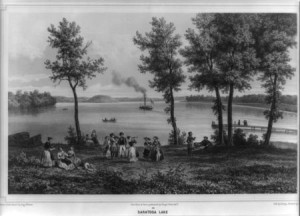
Saratoga Lake about 1850 with Snake Hill in the background and Moon’s dock to the right in the foreground.
The Lake had become a popular destination for visitors to both Ballston Spa and Saratoga Springs who were searching for things to do while staying at the hotels in both villages. Lake Houses were established on the west and south sides of the Lake to cater to these visitors. These guests desired something to entertain them between their visits to the mineral springs, meals at the hotels and hops and entertainment in the evening. A drive or ride, usually taken in the afternoon, offered beautiful scenery and a chance to show off some of the visitor’s fine horses and elegant horse drawn vehicles. Entrepreneurs saw an opportunity and either opened their homes or built new structures to provide refreshment and entertainment for these visitors. These Lake Houses generally did not house overnight guests, but offered drinks and supplied boats, fishing gear, and even offered bowling alleys. Some visitors also took advantage of walking paths and places to rest and enjoy the scenery. The Lake Houses also served meals, preparing the fish visitors caught, either in the Lake or in stocked ponds or serving the fish and game provided by hunters and fisherman like George Crum.[65]
These fish and game dinners became the most profitable part of the Lake House businesses as the rich and famous tried to outdo each other by throwing lavish private parties. The parties were an attractive alternative for anyone who dreaded sitting down in one of Saratoga Spring’s huge hotels and dinning at common tables at the same time as hundreds of other guests, everyone else in the hotel.
Among the Lake Houses in business when George began his career on Saratoga Lake were Avery’s, Abel’s, Riley’s, Loomis’ and at least for a short time the White Sulphur Spring hotel. Lake Houses were likely George’s best customers requiring significant amounts of fresh game and fish to feed their visitors.[66]
GUIDING AND A NEW FAMILY
For some visitors and residents of Saratoga Springs the fish and game dinners were not exciting enough, they also wanted to experience hunting and fishing for themselves and would employ guides to facilitate their trips. In addition to finding fish and game guides often organized the equipment and supplies, set up camp and cooked whatever the party caught or shot during the day. These adventures ranged from day trips in the immediate area to longer trips into the Adirondacks, the wilderness to the north of Saratoga Springs. Many of the accounts of George Crum’s life refer to him as an Adirondack guide, but the Adirondack guides that become famous in the late 19th and early 20th century lived in the Adirondacks. It seems more likely that George just made occasional trips with hunting and fishing parties to the Adirondacks and lived and worked most of the time in the area around Saratoga Lake.[67]
Guides had to be able to find fish and game, but the most popular ones were also good cooks. We don’t know if George’s time at the Sans Souci was the only source of his culinary skills or if he had additional training. There are some accounts of a mysterious Frenchman in the woods in stories about George and it is also possible that his brother in law Peter Francis played a role in George’s training as a cook, especially if they worked together after they moved to the Town of Malta.[68]
Most customers at the Lake Houses and likely many of those that hired George as a guide were visitors to Saratoga Springs, and may have only been in town for the brief Saratoga summer season. But there were also wealthy local residents who visited the Lake Houses and hired guides, and their trips were not limited to the brief Saratoga summer season. The only two clients from George’s earliest days serving as a guide and mentioned in articles about George were Saratoga Springs residents. Thomas and George Clarke were the heirs of John Clarke, the man who created Congress Park in Saratoga Springs and made Saratoga Springs famous by bottling and shipping Congress Spring water around the country. [69]
During the early days of his hunting and guiding business George was living in the Town of Malta on Saratoga Lake in an area called Riley’s Cove. Phillip Riley opened a Lake House there in the 1820s and his widow Lydia and her sons continued to operate it until 1889.[70] George may have been drawn to this spot because Riley’s was a customer and may have offered access to potential customers for his guiding service. Whatever attracted him to the spot initially he must have enjoyed living there, with the exception of a brief move to another part of the Lake, George lived within a mile of the Cove the rest of his life.[71]
It was about this time that George started a family with Elizabeth Bennett. It doesn’t seem the couple was ever married, but they had three sons, William, Richard and George Jr., all born between 1846-1848.[72] Elizabeth or Betsey, the daughter of Peter and Abigail Wright Bennett, was born about 1828, probably in the Washington County New York. [73] The Bennett’s were Native Americans, members of the Stockbridge band of the Mohicans, the same tribe that George claimed as his mother Diana’s ancestry. The Bennett family’s links with the Stockbridge are better documented than Diana’s, their names appear on tribe censuses and some of the family, including Elizabeth, lived on reservation lands and were included on tribal rolls.[74]
Peter Bennett, Elizabeth’s father, may have been born in Stockbridge Massachusetts, and may have lived later with other members of the Stockbridge at New Stockbridge in Madison County, but it appears that at some point he moved to the Upper Hudson Valley with his family. At least two, possibly three of his children were born in Washington County, New York and it appears that the family may have spent most of the 1820s there.[75] By the time George and Elizabeth started their family most of the Stockbridge had moved to Wisconsin and most of Elizabeth’s family was living there by 1850.[76]
One of George Crum’s family members suggested many years later that George and Elizabeth may have met when the Bennetts came to Saratoga Springs to sell trinkets.[77] An Indian Encampment in Saratoga Springs was a popular attraction during the season. The encampment offered an opportunity for visitors to see Native American artisans who made baskets, beaded bags and other decorated items while demonstrating other aspects of Native American Life. The encampments continued for many years and opinions about the authenticity of both the offerings and the participants varied according to observers.[78] It’s not clear if members of the Stockbridge tribe regularly visited Saratoga Springs or participated in the encampments, but they did have a presence in the Saratoga Springs area at least one year. A reporter wrote the following during his visit to Saratoga Springs during the summer of 1846.
“We found several Indian families of the Stockbridge tribe bivouacked on the western shore, the women employed at their handiwork of basket-making, from which they derive quite a trade with visitors; the men were either employed at fishing, or lying listlessly about their tents. They appear to live entirely upon fish and roasting-ears, and are, in market phrase, in good condition.”[79]
It seems unlikely that the Bennetts would have travelled from Wisconsin to Saratoga Springs for only a few months to participate in encampments or to sell items to the tourists. It seems more likely that at least some of the family may have remained in New York.[80]
Some accounts suggest that George and his young family were struggling at Riley’s Cove; at least one person remembered some of the children being born in what he described as a shack.[81] These conditions may have led George to make a temporary move closer to another Lake House, one that served more visitors from Saratoga Springs than Riley’s. By September of 1850 George and his family lived about three miles further North on Saratoga Lake in the Town of Saratoga Springs. It is possible that they had lived there for a few years before the census was taken, there is just no record. The house they rented may still have been modest and they were sharing it with another family, but the Specks had enough money to own a pig and cow, suggesting that George’s fortunes may have started to improve. [82]
Instead of hunter or guide, at least according to the census enumerator, George’s primary job was taking care of horses at an inn or tavern. It seems likely that George was employed by Loomis’ Lake House, since George’s family was listed immediately after Loomis’ in the census and as the largest of the Lake House in the immediate area, was most likely to employ someone to take care of their customers horses.
Loomis’ Lake House stood on a bluff over Saratoga Lake on the road from Saratoga Springs to the Lake on the same land where James Green had operated a Lake House and a Ferry since the early 1800s.[83] Loomis’ served visitors from Saratoga Springs who made the five mile drive to the Lake and like other lake houses Loomis’ provided boats and fishing tackle, and served fish and game dinners featuring some apparently very special fried potatoes. For more about these potatoes and how they became the potato chips we know today see my article “Saratoga Springs, New York: Birthplace of the Potato Chip.”
The fact that the census said he worked with horses doesn’t mean that George didn’t also continue to fish, hunt, and possibly even serve as a guide. His time working for Loomis’ may have allowed him to come into contact with many of his future clients. Most positions at the Lake Houses were seasonal and it appears George may have moved back to Malta after the season ended, since they were back in the Town of Malta near Riley’s Cove by the end of 1851.[84]
A FAMILY FALLS APART
In late 1850 or early 1851 another member of the Bennett family, Elizabeth’s older sister Esther, came to live with the Crums. There are several accounts of what happened after Esther‘s arrival, but they were recorded almost sixty five years later and differ on some of the details. What they agree on is that eventually George married Esther Bennett and Elizabeth Bennett no longer lived with her family in Malta.[85]
Some of the stories suggested that George was not happy with the way that Elizabeth treated him and kicked her out, while others suggested that Elizabeth chose to leave after George married her sister.[86] We don’t know what Esther’s role in the breakup of the relationship was, active participant or innocent bystander, or what Esther’s relationship was with her sister Elizabeth after she left Malta. George’s relationship with Esther appears to have been more successful; they spent the rest of their lives together. [87]
There is some conflicting information about where Elizabeth went and who went with her when her relationship with George ended. One version suggests Elizabeth took an infant daughter and another refers to this fourth child as Owen.[88] If there was a fourth child he or she did not appear in the 1850 census and has not left any other trace of their presence. It is possible that Elizabeth actually took her youngest son George Jr. with her, at least temporarily. George’s nickname was apparently Noun, which may have been transformed over time and through recollection into Owen. The 1855 census indicates that George Jr. may have lived away from the family for about two years between late 1850 and 1852.[89]
All of the sources agree that Elizabeth went to join her family, but disagree on exactly where the family was living, possibly Missouri, Wisconsin or more generally “The West.” [90] It seems likely she went to join her parents Peter and Abigail Bennett in Calumet County, Wisconsin on a Stockbridge Reservation there.[91] Elizabeth did not stay single for long, by 1857 Elizabeth had a new man in her life, Cornelius Aaron, also a Stockbridge, and they had a child, the start of a new family.[92] They eventually moved, with other members of the tribe, to a Stockbridge community in Shawano County, Wisconsin, where Elizabeth died December 4, 1898.[93]
Esther Bennett , sometimes referred to in the records as Hester, was born in Salem, Washington County, New York on November 22, 1823 and was not only five years older than her sister, she was even a little older than George.[94] While it doesn’t appear that Elizabeth and George were ever married, at least some people believed that Esther and George were married.[95] George’s second relationship didn’t produce any children, but it lasted much longer, George and Esther lived together for over fifty years.
We can only imagine what kind of interesting family dynamics the breakup of George’s relationship with Elizabeth and the start of his life with Esther may have created in the Crum family. And those potential issues may have been why George’s son’s Richard and William were not living with him in 1855. Richard, only eight years old, was a live-in servant for one of George’s neighbors, Philip Riley and his family.[96] William, the oldest boy, was living with George’s parents on the family property north of the Village of Ballston Spa.[97]
There’s no sign that either of the boys lived with George and Esther again. In the years before the Civil War both boys worked on neighbor’s farms, likely working for board as well as wages.[98] Only the youngest son, George Jr. remained at home during this time.[99]
A LAND OWNER AND A CIVIL WAR
Over the next two decades of his life George continued the hunting and guiding businesses, but also established himself as a farmer and began to build his land holdings. It marked his transition from poor to comfortable as his businesses became more successful.
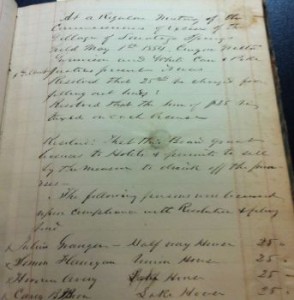
1854 record of Cary Moon’s license to sell alcohol at the Lake House. From the collection of Saratoga Springs City Historian.
George’s may have benefited from changes to Saratoga Lake Houses. In 1854 Cary Moon and his wife Harriet purchased Loomis’ Lake House and renamed it Moon’s.[100] Moon referred to his predecessor as carrying on the business in a small way and it seems that Moon did make the Lake House even more of a destination for Saratoga Springs visitors and the local elite. [101]
Not only did Moon’s offer the traditional fish and game dinners and the chance to sail or row on the lake they added new attractions and improved existing offerings to bring out visitors. A bowling alley, paths, benches, and summer houses dotted the ten acre property. Small steam powered boats left the dock for tours of the Lake and stops at other Lake Houses. [102] Visitors who wanted light refreshment sat on the porches or at small tables on the grounds and were served drinks and the crispy fried potatoes that eventually became known as Saratoga chips. The casual visitors on the porches only supplemented the profits made from Moon’s elegant fish and game dinners and legendarily expensive private parties. Moon’s became the most popular of the Lake Houses, gained a national reputation, and proved to be substantial customer for George; he supplied Moon’s with fish and game for nineteen years.[103]
But Moon’s was not his only customer; George also supplied the Cedar Bluff Hotel on the East side of the Lake. Henry Myers’ Lake House opened in 1864 and soon became a rival of Moon’s as a destination for elaborate fish and game dinners and private parties.[104]
As a supplier to the two major Lake Houses, and perhaps others, George gained a reputation among the Lake House owners as a skilled hunter and fisherman, and the owners may have recommended George to their customers. And for the first time George’s prowess as a hunter and a fisherman spread by more than just word of mouth, his name started to appear in print. [105]
All of this may have helped him land guiding clients like John Cutler, a New York State Legislator, who operated a Livery Stable and Freight delivery business in Albany. Cutler shared an interest with many of Saratoga’s wealthy visitors, horse racing. He owned several of the most famous trotters of the time and was part of the trend setting social circles that not only visited Saratoga Springs and the Lake Houses, but had the time and money to hire a guide for an outing. [106]
In 1856 George was able to do something that many people, especially those of color could only dream of, he purchased a house and some land. George purchased two acres of land from John and Jane Masten for $170.[107] The land sat at the top of hill about a third of a mile from Saratoga Lake, overlooking the cove and Riley’s Lake House. George would have been very familiar with the property since it was located on the road between Riley’s Cove, his former home, and Saratoga Springs and Ballston Spa. The property was located in the hamlet of Malta Ridge a small farming community that sprung up around a tavern run by the Chase Family and by 1856 had its own Methodist Episcopal Church and School house.[108]
A few years after George purchased his land the country was rocked by the Civil War. The War changed the nature of visitors to Saratoga Springs, but it had a much more personal impact on many American families including the Crums. We don’t know how George felt about the War other than he identified himself as a Republican, suggesting that he supported it.[109] Although his eligibility for the draft might have been questioned, George was registered for it along with many other Saratoga county residents. [110] He was not selected to serve and he didn’t choose to volunteer, but two of his sons eventually joined the Union Army. How much influence George may have had on that decision is unclear since neither Richard nor William were living at home at the time they joined, but soldiers between 18 and 20 were required to get their parents’ permission to join. Although it is unlikely that this rule was always closely followed given the Army’s need for man power.
Richard was working on the Nelson Ramsdill farm, a short distance north of Riley’s Cove in the Town of Saratoga Springs, when he joined Company F of the New York 2nd Veteran Cavalry Regiment in June, 1863 under the name Richard Crum. [111]
There are two unusual things about Richard’s enlistment. The first is Richard’s age, without a birth or baptism record it is difficult to be sure of his age, but the best evidence suggests that Richard was 15 or 16 when he joined the Army, although his enlistment records his age as 18. That was the official minimum age for enlistment, but it is clear that this, like the need for a parent’s permission to join, was not strictly enforced. Secondly, the regiment that Richard joined was not a “colored” unit as they were designated at the time. At the beginning of the War people of color were generally not allowed to serve, but once they were able to enlist over two years into the War, they served in segregated units.
While there are other examples of people of color serving in white units during the Civil War it was relatively rare. [112] Richard was described in his later enlistment papers as having blue eyes, dark brown hair and fair complexion, suggesting that he could possibly have passed for white. [113] But in this case he would not have had much of a chance of success since the other soldiers in Company F were also from the Saratoga Springs area and could have known Richard and his family. [114] It may just have been something that did not matter to the men he served with and Richard may have joined a white unit, because the United States Colored Troop units had not been formed in New York when he joined the 2nd Veteran Cavalry.
Eighteen year old William was also working as a farmer when he enlisted in the Union Army, but he enlisted as William Speck on August 29, 1864. He joined the 26th United States Colored Troops, Company H, one of the all African American units raised in New York State. William didn’t join when the 26th was first organized in February of 1864, but joined them after they were already stationed in the South for a term of one year. [115]
Both William and Richard survived the War and while they may have returned to the area it doesn’t appear they ever lived with George again. After the War Richard enlisted in the regular army, still in an all white unit, and served for over twenty seven years at various posts in the West.[116] William’s fate remains a mystery; the only trace I have been able to find of him, and it is only a possibility, is in Dodge County Wisconsin in 1880. [117]
While one account suggested that George Jr. also served in the Army I haven’t found any record and it seems unlikely since not only was he only 14 in 1865, he was listed as living at home at the time of the State Census in June 1865.[118] George Speck Jr., like his brother William seems to have disappeared after the Civil War.
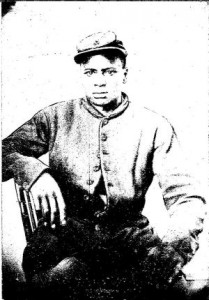
Joseph Golden, born Cornelius Woodbeck, joined the 54th Massachusetts as James McNulty and eventually married Sarah Adkins, George Crum’s niece.
Given the chance, many of men of color eagerly volunteered to serve. William and Richard weren’t the only members of George Crum’s extended family who joined the Union Army. Among those that served were Esther and Elizabeth’s brother Peter Bennett, George’s brother in law George Johnson, and several of George’s nephews. [119]
While most of the people in George’s life survived the war, the family did not totally escape tragedy. His sister Catharine’s husband, Richard Adkins, died while serving in the Union Army.[120] The death of another soldier may have played a role in bringing Nancy Hagamore into the Crum’s lives.[121]
It’s not clear how Nancy came to live in the Crum household. She was listed as a boarder in the 1865 census even though she eventually was an employee. She doesn’t appear to have been related to George or Esther, but George’s extended family would have known her husband’s family. She was born Nancy Thompson on October 10, 1843 in Cobleskill a community in the Mohawk Valley to the Southwest of Saratoga County. By 1862 Nancy was living in Stillwater and had married George Hagamore a member of an established African American family from the Saratoga Springs area.[122]
George Hagamore, didn’t wait for New York State to form a regiment, he joined other African Americans who left Saratoga Springs and travelled to Rhode Island to join what became the 11th Regiment U. S. Colored Troops Heavy Artillery, one of the first African American Units to be formed in September, 1863. His service and his life were cut short when like many other soldiers during the war, including Richard Adkins, George Hagamore died from disease.[123]
George Hagamore’s death may have brought Nancy to the Crum household; although it is possible she lived there before George’s death. The relationship between George Crum and Nancy Hagamore has been the subject of a great deal of speculation, during their lifetimes and in the years after. She has been identified as a boarder, a servant, an employee, and often as part of a polygamous marriage with George and Esther.[124] Whatever the truth Nancy was an important part of George’s life and remained a part of his household until his death.[125]
The Civil War brought change to both Saratoga Springs and George’s businesses. An important attraction was added to Saratoga Springs during the Civil War; a thoroughbred race track was established. Wealthy men and women who already visited Saratoga had something else to do and the track attracted new groups to Saratoga Springs, those that loved sport and gambling. Gambling and the track become important parts of Saratoga Springs attraction. These new visitors provided another pool of potential clients for George’s guiding business and kept the Lake Houses busy, increasing their need for fish and game.
George business apparently remained good during the War since he was able to expand his property before the War ended. In 1864 he and Esther purchased ten acres of land across the road from his home, land that was more suitable for farming and gardening than his original purchase. [126] Not only does this suggest that George was making a success of his businesses, but it might have signaled a shift of some of his time away from the woods and lakes, for the now forty year old George.
George purchased more land in 1870, also presumably for farming. There were a couple of things that set this purchase apart from his earlier purchases of land. His first two pieces of land were just across the road from each other, but several farms and a road stood between George’s house and his new purchase.[127] Also apparently for the first time George borrowed money to make a land purchase.[128]
Even after this purchase George’s farm remained smaller than many of his neighbors, but he raised many of the same crops and kept much of the same livestock. The farm produced oats, potatoes, and apples, and he owned dairy cows, pigs, sheep and chickens. [129]
While records survive that give details of many aspects of George Crum’s life there isn’t much information about his relationship with his children, parents and siblings. His parent’s relationship included some separations, but we don’t know if it was caused by issues in the marriage or finances.[130] Abraham and Diana lived together for a time after Abraham’s pardon and release from prison, but appear to have separated after the 1860 sale of the land they inherited from George’s Grandmother, Catrina Crum.[131] Abraham lived with his son George at times in the years after the sale, but also lived on his own in the nearby Town of Milton.[132] He may have been living with George or possibly his daughter Mary Francis when he died in August of 1872 in the Town of Malta.[133]
Diana doesn’t seem to have ever lived with George and his family. After the sale of the Crum homestead she lived in Ballston Spa and her twenty six year old son Abraham lived with her.[134] By 1865 she had moved in with her daughter Mary Francis and her family in Malta. She passed away soon after in October, 1868.[135]
CATERER AND RESTAURANTEUR
Sometime during 1870s George added still another occupation to his growing list of business ventures, caterer. This new business may have started slowly and it may not have been something he did regularly, but George began to host and serve fish and game dinners at his home near Saratoga Lake. There may have been a variety of reasons for this change. George was facing his 50s, game was getting scarce, he had the resources of his growing farm at his disposal, and he may have been filling a void created by the death of Peter Francis.
In many ways the hotels and Lake Houses were victims of their own success by the 1870s since it was growing harder to find game in the area. Demand wasn’t just limited to the Lake Houses; hunters could sell their game birds at almost any rail road station to agents who supplied hotels and other eateries.[136] Longer trips to the Adirondacks were needed to supply the hotels and lake houses, but game was still plentiful enough for successful trips into the woods for small parties of hunters. This may have led the aging Crum to concentrate on guiding and preparing meals.
The scarcity of game may also have led George to become involved in conservation. George served as game constable for Malta. It was an elected office and George ran for it in 1873 and was elected several other times in the 1870s.[137] This apparently didn’t mean he was immune to the temptation of taking more than his limit though; he and his party were fined for violating game laws in the nearby town of Galway in 1880.[138]
At the same time George also increased his commitment to farming and began growing buckwheat and Indian corn in addition to his oats, potatoes and apples. He also had plenty of land for a market garden, but apparently didn’t sell much from it, possibly because he was using it to provide for his family and guests. While George’s farm was similar in many ways to his neighbors, just on a smaller scale, there were some differences. Almost all of George’s land was improved, and at least until the 1880s, the last year information is available, his holdings did not include timber land or wood lots and he did not sell firewood as most of his neighbors did. There are also signs by 1880 that he may have started to raise chickens on a larger scale, possibly to supply his catering business.[139]
Peter Francis, George’s brother in law, died in 1874 after years of serving visitors fish dinners at his small home on the south end of Saratoga Lake.[140] Years before George Crum gained fame as a cook and restaurant owner Peter Francis entertained Senators and Congressman. There were stories published about him in newspapers, Harpers Magazine, and in a book of local history, William Stone’s Reminiscences of Saratoga and Ballston. [141] The stories about Peter not only depicted him as a character, but also as a skilled fisherman, excellent guide, outstanding cook, and often emphasized his Native American ancestry. George Crum began to be described the same way.
We don’t know if George and Peter cooperated in business or saw each other as rivals. By the 1870s while George was on his way up, but Peter Francis and his family faced several setbacks. In 1871, Peter’s home and business were destroyed by fire and he had to rely on the support of the community to rebuild.[142] It took a few years to reopen and it’s not clear how successful his business was after the fire. Following Peter’s death his widow Mary tried to carry on the business, but she was not able to match Pete’s earlier success and the Francis family sold the property in 1878.[143]
In 1877 George received a brief mention as being responsible for the catering of a fish and game dinner at Riley’s Grove attended by a number of Ballston Spa residents. The fact that his name was even mentioned suggests that he had some fame as a cook.[144] It was a reputation he seems to have developed in the woods cooking over an open fire, while he guided parties on hunting and fishing trips. This mention in the paper may be the result of his transition from cooking in the woods into bringing the parties to his home. That move enabled him to serve more people, gave him as chance to make money beyond the limits of the hunting seasons and could have exposed his skills to more people, even those who edited newspapers.
One of the men who hired George as a guide and became a frequent visitor to Crum’s house was John McBride Davidson. Davidson owned the High Rock Spring Company in the 1870s and had homes in both Saratoga Springs and New York City.[145] He was an avid hunter and loved woodcock, often making arrangements so hunters brought him the first birds of every season. He also became a well known fisherman in Saratoga Springs.[146] These interests could have brought George Crum in contact with him, or they may have been introduced by one of Crum’s earlier clients, and Davidson’s friend, John Cutler.[147]
Davidson in turn appears to have introduced his circle of friends to George Crum’s skills as a guide and more importantly as a cook. Among his friends was William H. Vanderbilt, the oldest son and heir of Cornelius Vanderbilt.[148] A story written during George’s lifetime suggests that he won Vanderbilt’s admiration by preparing Vanderbilt’s favorite game bird, canvas back duck when no one else in Saratoga Springs could. Crum had never cooked them before, since they weren’t found near Saratoga Springs, but he managed to please Vanderbilt.[149]
Davidson had another circle of friends or perhaps more accurately associates from Tammany Hall and Boss Tweed’s infamous ring in New York City.[150] These politicians became another important circle of clients for George Crum. With Davidson, the politicians and Vanderbilt among his clients Crum’s prospects were better than ever. Not only would these men have provided plenty of business on their own, their patronage brought Crum to the attention of other wealthy clients and to newspapers.[151]
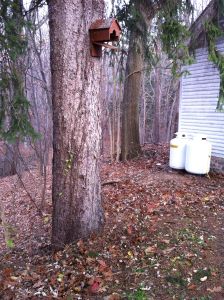
Top of the hill leading down to the spring and pond at the rear of George Crum’s property in the Town of Malta.
To better serve the guests at his home George made some changes to his property. He damned up a spring to create ponds for trout and bass, not only to make sure they were quickly available when he needed them, but also to make sure he could offer them when they were out of season.[152] Although the license application doesn’t survive George may also have gotten his first license allowing him to sell alcohol at this time.[153] While George continued to hunt and fish and may have still guided parties in the woods, he hired other hunters and fisherman to help fill his ponds and to provide him with game. [154]
There wasn’t enough room in George’s small house to feed his clients so the meals were served at the bottom of a hill below Crum’s house, near the spring that kept the wine cold and fed the fish ponds. George, Esther and Nancy all had a role in entertaining, George handled cooking the fish and game, Esther prepared the vegetables and Nancy supervised service and kept things running smoothly. [155]
While occasionally a woman may have joined in on these rustic excursions, the bulk of George’s customers would have been parties of men. Serving meals down the hill and away from the kitchen, slowed things down and may also have meant that food was served cold. Whether inspired by the demands of his clients for improved service or his own inspiration George decided that a better kitchen, a dining room and a bar would not only make everyone more comfortable it would also mean that George could serve more customers and could attract parties that contained women as well as men.
CRUM’S PLACE AND FAME
In the early 1880s George added a building between his house and steep hill and spring at the rear of his property.[156] It contained a kitchen at the rear, a dining room, and a barroom that could be separated from the dining room with a sliding door. There was a fourth room that was used as an additional dining room or as a waiting room.[157] French doors opened out onto porches that ran around most of the building and gave a view of the lake on one side. A coat of white paint and green shutters matched George’s house and above the door facing the road George mounted the head of an Elk, a present from Edward Kearney, one of Crum’s clients. Underneath the Elk was a simple sign that said Geo. Crum with a small fish symbol. [158] There sign didn’t say Crum’s Place, but that seems to be how, at least eventually, George referred to his business. It’s not clear if this started with visitors calling George’s home as Crum’s Place, before the new building was erected, or if the name may have come when the new building was opened.
Crum’s operated like many of the other Lake Houses; he hosted private parties, but also served fish and game dinners to walk-ins when private parties did not require all of Crum’s rooms. Crowds came to the Lake and Crum’s in the late afternoons for dinner and then returned to Saratoga Springs for the evening’s events and entertainment.[159] Some rode in their own impressive horse drawn vehicles, others hired equipment, and still others travelled as a group in chartered transportation such as a Tallyho coach or omnibus.[160] A new road opened in 1882 that trimmed the trip from Saratoga Springs to George’s place from seven miles down to four and a half miles making the ride even more attractive.[161]
When a group of customers arrived at Crum’s they would often be greeted by Nancy Hagamore or George Crum near the road.[162] They would take the order for the entire party from a very limited menu and only then allow visitors to walk past the house down a path through berry bushes and cherry trees toward Crum’s Place. If there was no wait it took about thirty minutes for the meal to be prepared, but since Crum’s could only hold about 30 people there often was a wait. At least in the beginning George had no problem making even the rich and powerful wait their turn if the restaurant was already full.[163]
While they waited patrons were offered champagne, wine or a whiskey cocktail and they could choose to wait in a small room decorated with fishing tackle or walk down the hill to the spring where they could rest on some old church pews arranged around the ponds. [164] And in a move that seems totally at odds with the rustic nature of the meals, for at least one season George employed a singer on Sunday’s to entertain his guests. [165]
Once inside Crum’s there were no individual tables for dinners, only two large tables surrounded by plain cane bottomed chairs.[166] Among the items served at different times were black bass and trout from the lake or George’s fish ponds, along with chicken, partridge, woodcock, and other game birds. The meals also included items from George’s farm in season; corn roasted on the charcoal range or boiled, Esther’s stewed potatoes, a salad of cucumbers, tomato and lettuce, and bread prepared by Nancy. [167] And at the end of the meal George offered fruit, almonds, cheese and coffee. [168]
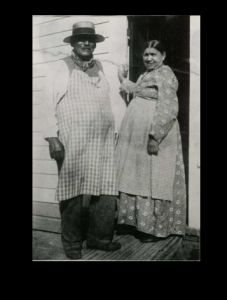
George and a woman I believe to be Esther Crum, probably at the backdoor of their house in Malta. c. 1890
Accustomed to cooking on a campfire with his guests all around him George may have tried to keep this experience alive by constructing a kitchen that opened onto one of the porches and allowed visitors to see what was going on in kitchen.[169] The simple kitchen contained a prep table across from the brick charcoal grill where he did all his cooking. On the back wall was a cooler that held all the fresh products for his dinners including the fish and game cleaned and prepared for the meals that day.[170]
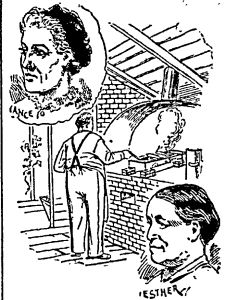
George Crum at work in his kitchen along with images of Nancy Hagamore and Esther Crum. New York Herald August 4, 1889.
While George and Nancy interacted with the guests, Esther remained in the house where only a few visitors were welcome. That was where she prepared the stewed potatoes and other vegetables for the meals. There is no indication that Saratoga Chips were ever served at Crum’s, but visitors did rave about the stewed potatoes both at Crum’s and when his protégé’s served them after Crum’s closed.[171]
The meals were not cheap; writers often suggested that the prices at Crum’s and Moon’s were comparable to those of New York City’s most elite restaurants. A meal without wine at Crum’s was $2, but most of the private parties ranged from $5 to $10 a plate when drinks and special requests were added.[172]
According to George it wasn’t the size of his restaurant that held him back it was the ongoing challenge of finding good game birds and enough servers.[173] Apparently George had mixed success in finding qualified servers, some patrons described them in unflattering terms and at other times were shocked to find well-educated college students serving their food.[174]
Not all of George’s customers came from Saratoga Springs; many Troy residents who summered in cottages in the Village of Round Lake in the southern part of the Town of Malta made the relatively short excursion to Crum’s during the summer season.[175] During the winters, horse races on frozen Saratoga Lake attracted horsemen from as far away as New York City, but George also entertained parties from Schenectady, Troy, Albany and Ballston Spa during the winters. Something he could not have easily done before he built Crum’s Place.[176]
Some stories written during George’s life suggested he was set up in business by William Vanderbilt or some of his other wealthy patrons.[177] While it’s possible they played a role, it appears that George financed most of the project on his own. He took out a mortgage on some of his land and raised $400, which may not have been enough to pay for everything, but would indicate he was an active participant. [178] It is possible the authors of these stories just underestimated George and assumed that he wasn’t capable of building his own business.
Even though George was serving some of the same people he once served around campfires at the bottom of the hill behind his house, newspapers did not seem to take notice of his visitors until he built his restaurant. The earliest mention I can find of Crum’s Place is in the New York Times of May 4, 1883 which suggested that that Crum’s and Moon’s were the place to go “for game and brook trout, and such rarities, which are too expensive for the general hotel table.”[179]
This was the first of dozens of items published in local and national newspapers, travel guides, and books about parties at Crum’s Place, George’s skills as a caterer, and profiles of George’s life. These articles ranged from brief mentions of someone hosting a party at Crum’s to substantial stories about George including illustrations.[180] While there are photographs and illustrations of George from this time some of these newspaper accounts give us additional information about George, although it is clear that the writers were often insensitive and inaccurate.
“The only indications of age are in his voice and in the thin, short gray whiskers on his chin. His step, once light and elastic, is heavy, but that is due to high living and the consequent avoirdupois that has overtaken him since he gave up the chase. His eye, though there is a good deal of Indian in it, is as soft as a gentle woman’s, and his voice is low and slow and very pleasing to the ear. Every remark is accompanied by a smile and punctuated with a little cough that lends to his speech a peculiar charm.
Though an Indian in appearance, Crum has both Spanish and German blood in his veins and there are times when the close observer can detect in him characteristics of the three races. He comes of the Stockbridge tribe.” [181]
“Crum, George is his front name (under the circumstances I can’t say Christian name) is an Indian, just a plain, unvarnished copper-colored, black-haired, black-eyed Indian, who wears baggy Jeans breeches, a hickory shirt, and an old straw hat; but instead of the tomahawk he wields the gridiron, and instead of scalps ‘round his ample waist he flourishes an apron.” [182]
George may have merited newspaper coverage for several reasons, the writers perceived George as a character, his clientele were the celebrities of the time, and they may have been curious why wealthy people would wait in line, dine in a rustic setting, and then rave about the abilities of the someone who did not conform to their idea of a typical chef.[183]
In many of the accounts his Native American ancestry and experience as a hunter, fisherman, and guide play a prominent role. This may have appealed to American’s fascination with nature and their often conflicting and confused image of Native Americans as both a “noble savage” and a terrible enemy. At the same time the Country’s army was fighting with tribes in the West, novels and the popular press also presented a romantic view of some of Native Americans. Many of the accounts also threw in a bit of scandal and perhaps what they saw as George’s refusal to follow the rules of society. They suggested that George shared his small home with not one, but two wives, referring to Esther and Nancy.[184]
While his background made him interesting, his patrons were probably the most important element in focusing the attention of newspapers on George. The tiny restaurant attracted some of the most wealthy and powerful men not just in New York but in the United States. Crum’s was very popular with politicians; he is said to have served three Presidents, Arthur, Grant, and Cleveland.[185] He was visited by Governors, United States Senators and Congressman representing a variety of States. Politicians from New York City including the men of Tammany Hall, the notoriously corrupt and powerful wing of the Democratic Party in the City also made use of Crum’s.[186]
Businessmen who came to Crum’s included William H. Vanderbilt who was a frequent visitor until his death in 1885, and others with a national reputation, such as Gould, Hill, Lorillard, Travers, Wall, Jerome, Whitney and Belmont, names that may only spark some recognition in Saratoga Springs today, but were national celebrities before the turn of the century.[187] A page could be filled with more of Crum’s wealthy patrons, but few of the names would be recognized today, even though at that time their actions were followed in society columns like Hollywood celebrities of today.
While notoriety may have given George’s business a boost, his success was built on his skills in the kitchen and by all accounts George Crum was an excellent cook. Perhaps the greatest testament to George’s skill as a cook was the patronage of local restaurateurs like Cary Moon, Edward Kearney, Albert Spencer and Charles Reed. Kearney succeeded Moon as one of the owners of Moon’s Lake House and Albert Spencer and Charles Reed succeeded John Morrissey as owners of the Clubhouse in Congress Park.[188] There are stories that credit George’s absolute control over the kitchen, his ability to get the best ingredients, attention to detail, and skill at his innovative and custom made charcoal grill, as the keys to his reputation as a chef. He reportedly never left anything to sit on his grill; he was constantly turning and basting, tamping and changing his fire, and rarely left the kitchen. Some stories called him the best cook in Saratoga, others the best cook in the country and recounted tales of famous restaurants like Delmonico’s trying to lure him to work in their kitchens. [189] George’s status as a cook became accepted enough that writers used him as a standard to compare other cooks to even after Crum’s closed. [190]
George was also respected because of his ability to obtain the best and freshest ingredients. He grew his own corn and picked it fresh when it was time to cook it. He raised fish in ponds on his property to insure freshness and availability, even when the fishing was restricted by game laws. As a former hunter and fisherman he had strong relationships with those that followed in his footsteps. He employed as many as seven hunters and five fishermen and even if hunters worked for other Lake Houses or agents he was able to get first choice from their daily hunts.[191] He also raised his own chickens to serve when game bird seasons were over ensuring that fresh fish and chicken dinners were always available.[192]
George also deserves some credit for being successful when other Lake businesses were not performing well. The 1880s, when George built his place, may not have been the best of the times for Saratoga Lake in general. People dreamed big in the 1870s when very popular rowing regattas were held on the Lake, but the dreams were not realized. Even new attractions like the Saratoga Lake Railroad and the huge steamer the Lady of the Lake were underutilized by the public.[193] Other Lake Houses were struggling, Cary Moon sold Moon’s Lake House in 1885 at a time when the nearly forty year old building was starting to deteriorate and business was falling away.[194] Promised improvements were not made by the new owners and Crum’s was able to capture much of the fish and game dinner business. By 1890 it was estimated that George Crum had two thirds of that business while Moon’s then run by Hiram Thomas and a new Lake House run by James H. Riley on Lake Lonely split the other third of the dinners.[195]
The presence of two James Riley’s in the Saratoga Springs area at the same time and in the same business makes for some confusing records. George’s friend and neighbor James Riley in Malta was the son of Phillip and Lydia Riley and ran the family’s nearly eighty year old Lake House.[196] The other, James H. Riley was famous as a regatta rower and a relative newcomer to serving visitors. His Lake House was located in the Town of Saratoga Springs a few miles to the north of Crum’s and Riley’s.[197] By 1889 James Riley was out of the Lake House business in Malta and James H. Riley’s business in Saratoga Springs was just starting to hit its stride.[198]
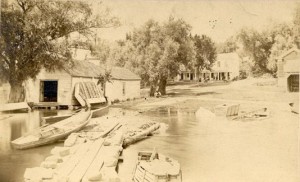
Crum’s neighbors the Riley’s operated a Lake House for over 80 years. Collection of Brookside Museum, Saratoga County Historical Society. c. 1899
All of George’s success seems to have started to take a toll on him and following the 1891 season he was telling customers and newspapers that he was going to retire. In September he announced that he not only planned to retire, but planned to sell his place and move to Brandt Lake in the Adirondacks.[199] But something made George reconsider retirement. A multi column profile in the New York Herald made no mention of retirement and he was back in the kitchen for the 1892 season. [200]
The newspaper profiles may have convinced George to have his story immortalized in another way, by purchasing a biographical sketch in a history of Saratoga County. This profile is the source of a lot of the information we have about George Crum and his family, so it is important to understand how it was created. A publisher, in this case Gresham and Company out of Philadelphia would come into town with an introduction from someone locally prominent and seek out subscribers before it was published. The author’s of the publication, Wiley and Garner worked for the publisher and wrote, edited or compiled histories around the country. The writers would collect information from a subscriber and charge the subject based on length of the article.[201] George’s choice to pay for this profile and the information he chose to include not only illustrates his success, but also shows how he wanted people to see him. He was shrewd enough to make sure that the parts of his life story that interested newspaper writers in the past were included and elements of his life that he may have felt would not be viewed positively were not included.[202]
While George Crum reconsidered his retirement in 1891 it seems that things were not the same over the next few seasons. According to some newspaper accounts George was changing and was no longer always welcoming and not quite so even handed in how he treated his customers. Earlier profiles contained stories about George Crum refusing to play favorites and sticking to rigid but fair rules. Among the rules were no special orders, you waited your turn, and you might be turned away if you were late.[203] But now stories started to portray George as a sometimes grumpy chef who played favorites, sending some parties away and allowing others to move to the front of the line for service. Some of the profiles suggested that he could be swayed with a gift of a cold bottle and that George may have had some issues with alcohol.[204] When later writers composed their stories about George Crum and the potato chip this side of George may have inspired the image of George Crum as a temperamental cook.
George decided to retire once again after the 1894 seasons. From all accounts it was not because business was bad, as a matter of fact the profiles continued and some accounts suggested that 1894 was the best year for the Lake Houses in some time.[205] Instead of selling the business or just shutting it down George chose to lease the business and continued to live on the farm. Over the years, George seems to have maintained a close relationship with neighbor and fellow Lake House owner James Riley. Even though James Riley and George were potentially business rivals in Malta they not only dealt with each other in some land transactions, James signed a bond on some of George’s liquor licenses and was involved in the formation of a club whose sole purpose seems to have been to keep the liquor flowing at Crums.[206] By the 1890s the Riley’s had gotten out of the Lake House business, but Ben Riley, one of James’ sons continued to be interested in the hospitality industry.[207] Ben Riley began his education in the business when he worked at his family’s Lake House and as a boy he also worked supplying George Crum with fish. At some point he began to work with in the kitchen at Crum’s, where George taught him his style of cooking. [208] This made Ben Riley the obvious choice to carry on Crum’s Place when George retired in 1895.[209]
There’s evidence that George Crum continued to at least be somewhat involved in the operation of Crum’s Place even while Ben Riley was running it. In 1897 the Town of Malta went dry and Crum’s Place, along with other businesses in Malta, lost their right to sell alcohol. This posed a major threat to Ben Riley’s and indirectly George Crum’s profits.[210] Fortunately for them, there was a loophole in the new law that allowed private clubs to provide their members with alcohol. In March, 1897 the State of New York incorporated, “The George Crum Fish and Game Club of Saratoga Lake.” This according to its charter was formed, “for social, mental, and physical recreation and the improvement of its members and the community.” The Directors were George Crum, John B. Hall and James Riley of Malta, and Eben S. Lawrence and Irving W. Wiswall of Ballston Spa, with Benjamin Riley, selected as President. In addition to the officers some of Ballston Spa’s most prominent citizens signed the articles of incorporation.[211]
George must have missed cooking, because in the summer of 1897 he was back in the kitchen, but this time in someone else’s kitchen. Henry Newman took over the newly rebuilt Moon’s Lake House and brought in a well known chef to cook fish and game for his first season. George’s role was even featured in some of the advertising for the Lake House and while he was cooking for Newman that summer. George was also interviewed by a reporter who asked for his recipe for Saratoga Chips, not as the inventor, but as a Lake House cook. [212]
It doesn’t appear that George cooked a second season for Newman, and if he took some time off to relax it didn’t last long, by 1899 George was back in the catering business.[213] It’s not clear if it was George’s idea to end the lease and get back in his own kitchen or if Ben Riley just had bigger plans and decided to move on. In 1899 Riley purchased Arrowhead, a mansion a few miles to the North of Crum’s overlooking Saratoga Lake. With the help of investors he converted the large home into his own Lake House and kept the name Arrowhead. Riley brought the style of cooking he learned at Crum’s to his new restaurant, added his own touches and began to draw crowds to his much larger Lake House.[214] Eventually he sold Arrowhead, moved to the area around New York City, and became a well known restaurateur there. [215]
George reopened Crum’s Place and this time, perhaps to distinguish his cooking from his former protégé and new competitor Ben Riley, he did some advertising. He promised “delicacies served in the highest style of the chef’s art” by “the original and only George Crum.” [216] We don’t know if Nancy and Esther had retired with George or stayed on and worked with Ben Riley, but it seems likely they were also back at his side when George returned to the kitchen. They may also have had help from a new protégé in the kitchen James H. Lowell Jr.[217] Despite his age, about seventy five, George was far from frail, in September 25, 1899 his wagon was struck by a train and he was thrown from it, but sustained only some bruises.[218]
Crum’s Place only stayed open for another two years and while the reasons that George retired for the third and final time aren’t recorded, given that he was almost eighty years old it was certainly understandable that he may have wanted to retire.[219] If he planned to rent out Crum’s Place this time he was not able to find a chef and Crum’s Place closed down.[220] Unlike 1891, when Crum contemplated retirement and 1894 when he actually left the business, this retirement received very little notice in the press, but it also seems to be the first one that lasted. George left the Lake House business when it was on the verge of big changes. The small Lake Houses started to be replaced by larger more elegant buildings and gradually automobiles replaced horse drawn vehicles and gambling replaced walks along shaded paths.
OTHER BUSINESSES
While most of the attention has always been given to his catering, fishing, hunting, and guiding careers George Crum had other business interests. Even though he could neither read nor write he put his money to work for him by holding mortgages on various properties around Malta and Ballston Spa. It doesn’t appear that these were favors for family members or neighbors, but investments since he not only created his own mortgages he sold some of his mortgages and acquired existing mortgages from others.[221] At the peak of his lending in 1896 and 1897 he had $4,740 out in loans. And these mortgages may only tell part of the story; George may also have made smaller loans like the $50 he leant to Patrick and Maggie O’Neil. We only know about this loan because the O’Neil’s didn’t pay George back and he sued them to recover the cash.[222]
George also continued to acquire land in the Town of Malta adding to the property directly around his house and to the land he owned to the West on the other side Rowley Road. In three transactions he added thirteen acres around his house and purchased thirteen acres of land bordering on the lot he owned to the West.[223]
In the late 1890s George added thirty eight of acres to the property he owned on the south side of Malta Avenue bringing his total land holdings to eighty acres.[224] Unfortunately there is no record of what George’s plans were for the land or how he eventually used it. While earlier Agricultural Censuses contained information about how George used his land that information was not preserved after 1880. He may have increased his production of some crops and must have been viewed as some sort of authority since he was quoted in a local paper about his thoughts on the price of hay from Malta.[225] All of the land may have been meant for the farm, but it is also possible that George had other plans that he was never able to fully realize.
Some of the property George acquired came with houses, and it’s possible that he used these as cottages for guests, something that the some owners of other Lake Houses offered or he may have used the buildings to house some of his staff and relatives.[226] Peter Francis’ son George W. Francis and his family lived in a rented home near Crum’s, possibly one owned by George. He was a Fisherman, likely working for George, and Francis’ wife Carrie and other members of the family may have also helped out at Crum’s Place.[227]
George continued to be actively involved in his farm even into his 80s, he was still listed as a farmer, not a retired farmer, in the 1905 and 1910 censuses.[228] That doesn’t mean that he didn’t require help running the eighty acre farm. While George’s children were long gone, a new member of the family helped George on the farm, his great nephew George A. Francis. George A. Francis came to live with the Crum’s after his family seems to have fallen apart. His father George W. was convicted of burning down a barn in Crum’s neighborhood and George A. Francis’ mother seems to have abandoned the family after that.[229] In 1895 George W. Francis asked George to adopt his son George A. Francis and George A. came to live with the Crum’s. They were close enough that George Francis referred to George Crum as pop and he spent the rest of his life in Malta Ridge and in George’s house .[230]
George employed others as well, sometimes having to come up with creative solutions to find help. In 1907 George bailed a man out of jail in return for his promise to work on his farm, a story that got national attention. [231]
It wasn’t all work for George; he managed to find time to hunt and fish and at least on one occasion travel with his wife.[232] Because we have to rely on newspaper accounts for this type of information there really is no way to know if this was a rare trip or if the Crum’s made other trips.
George’s companion of over fifty years, Esther passed away on August 14, 1906 at the age of 86. She was buried as Esther Speck in one of the plots the Crum’s had purchased years earlier in Malta Ridge Cemetery. [233]
THE FINAL YEARS
George, Nancy Hagamore, and George Francis continued to live on the farm in Malta Ridge following Esther’s death, but George now in his 80s started to have health problems and began to decline during the last few years of his life.[234] He died at his home on July 26, 1914, less than two weeks after his 89th or 90th birthday. His funeral took place at home and he was buried as George Speck at the family plot in Malta Ridge Cemetery. [235]
Word of George’s death was carried in papers around the country, and many of the obituaries included not only stories about this “half bred” or Indian’s days as a hunter, a guide and a celebrated cook, but listed many of his famous clients. Some of the stories exaggerated his age, his wealth and either through confusion or information we don’t have access to, his relationship with Nancy, suggesting that he had been survived by his wife.[236] Only two of the obituaries, though they were reprinted in a few other papers, credited George Crum with the invention of Saratoga Chips, the remainder made no mention of any connection to them.[237]
During his life, much of the credit for George’s success was given to others, mainly his patrons who were said to have set him up in business. Perhaps this was because it was hard for people at the time to imagine that a person of color who could neither read nor write, could succeed the way George Crum had. Even if they accepted that George deserved credit for his success, there was a perception that he wasn’t capable of managing his own affairs after he had made his own money. The idea was wide spread enough in 1897 that George felt compelled to answer this charge in an advertisement in the Ballston Daily Journal.[238] The ad specifically addressed a will prepared a few years before and asserted that the man who made if for him, probably James L. Scott his attorney, was someone George trusted and was a best friend. He acknowledged that he was not able to read the will, but relied on Thomas Kerley, an officer of the Ballston Spa National Bank, to read it to him. He then listed all the witnesses to the signing of the will, a who’s who of Ballston Spa businessmen.
From this distance we don’t know if these concerns had any base in fact or how big a role others played in George’s success. It appears that George actively managed his affairs and dealt with a wide variety of people, but of course his lack of education meant he had to rely on others more than perhaps he would have liked. I have found only two real estate transactions that show any sort of loss and in both cases they could be completely legitimate. George sold a mortgage he held at a significant discount to James L. Scott his attorney and friend, but it could have been in exchange for services or it could have been because George felt his chances of collecting the debt were questionable.[239] In 1914, months before his death, George assigned a mortgage he held to James H. Lowell Jr. for services rendered. While there is no explanation of what those services were, Lowell did work with George, and was referred to as one of George’s protégés for years after George’s death. [240]
Unfortunately questions about George’s competence and potential manipulation reappeared after George’s death in a battle over his estate. Richard Crum, apparently George’s only surviving child decided to challenge a will that George had created in 1912.[241] If it wasn’t for this battle over George’s estate we would know very little about his family life and the events that led to the departure of Elizabeth Bennett from his home in about 1850. George left Richard out of this will, not apparently for any slight or offence, but because George believed that Richard had died in the San Francisco Earthquake. It’s not clear where George got that idea, but he repeated it to others and honestly seemed to believe it.[242]
After his Civil War service Richard joined the United State Army and served on posts in the West. [243] While he came back for the rare visit between enlistments, he did not settle in Saratoga Springs when he retired in 1899, instead he remained in the West.[244] It doesn’t appear that there was an ongoing exchange of letters, not surprising given George’s inability to read and write, but it appears no one else in the family had heard from Richard in sometime either. He was living in Junction City, Kansas, the location of Fort Riley, his last post, when George died in 1914.[245]
George had apparently remembered Richard in an earlier will, when he believed Richard was alive, but he must have known or believed that his other two sons William and George were dead since they were not discussed. The earlier will appears to have been written to also take care of Esther and George A. Francis, his great nephew and unofficial ward, but it is not clear what provisions were made for Nancy Hagamore. [246]
After Esther’s death, and Richard’s purported death in 1906, George created another will. It appears that George made other arrangements to provide for George Francis outside of his will, but used his new will to take care of his loyal companion Nancy Hagamore. [247] This will excluded Richard entirely and left a life interest in George’s estate to Nancy. When she passed away the estate was to be divided by George’s sister Kate and some of George’s nieces and nephews. These beneficiaries included some of his sister Kate and Delia’s families, but made no mention of Diana’s or Mary’s children, even though at least some of Mary’s children were still alive. I haven’t been able to find anything about Diana’s family after the 1870s and perhaps George lost touch with them as well. For whatever reason he also chose not include all of his sister Kate’s children in the will. [248]
Nancy and the family first learned that Richard was still alive from an article in the Saratogian relating that Richard had written to the paper because he had been left off of the list of survivors. It seems likely that at least someone in town was in communication with Richard and it may have been a former army companion Edwin Ham. [249]
Richard apparently decided to contest the will, hired local attorney Jesse Stiles and travelled to Saratoga Springs. They challenged the will on two grounds, first that Richard, as his son, had an interest in the estate, that he was only excluded because George believed him dead. They also contended that at the time the will was prepared George was incompetent.[250]
Nancy Hagamore and the other beneficiaries of the estate retained their own attorney Frederick Chew of Troy and defended the will on the grounds that George was competent, that he honestly believed Richard dead, and that Richard was not actually George’s legitimate heir since George never married Richard’s mother Elizabeth Bennett.[251]
Over the next eight months several hearings took place in Surrogates Court and area newspapers repeated the most scandalous bits of the testimony. Much of it dealt with the details of George’s relationships with Elizabeth and Esther Bennett, but interestingly never discussed his relationship with Nancy. Testimony seemed to prove that George was not married to Richard’s mother so Richard had no legal claim to the estate, but testimony also seemed to prove that George may not have been competent when he made the will. That may explain why both sides eventually agreed to a compromise before the Judge had to make any kind of ruling. Richard Crum and Nancy Hagamore agreed to share the estate and bought the interests of the other heirs for only $40 each.[252]
This size of George’s estate did not match the initial speculation that it may have been $100,000, nor does it reflect more modest estimates that suggested that George Crum had acquired $75,000 before he retired. [253] There is no sign of any cash in the records, no stocks, and no securities. Even the land that George had purchased over the years, rather than appreciating was actually appraised for less than he paid.[254]
It will probably have to remain a mystery what happened to George’s money, not the $100,000 that newspapers speculated might be there, but the money that he was able to invest in mortgages. There is no sign that he spent it on a lavish lifestyle, but it is also possible that there were business deals that we don’t know about went wrong, or money was lost in some other way. It’s possible that the money was never made part of the estate and it passed more directly into hands of his heirs.

View of Crum’s Place from the road, the house in the forefront was built after George Crum’s house was torn down int he 1960s. 2012 Photo.
The inventory of estate shows that George, George A. Francis, Esther and Nancy Hagamore lived very simply. The house contained very few pieces of furniture and decoration and none of it had much value. The inventory does contain a few traces of George’s life as a hunter, fisherman and restaurant owner including fishing tackle, guns, game bags, buffet refrigerators, tables and cane bottomed chairs.[255]
CONCLUSION
While George acquired a great deal of fame during his life for his cooking, hunting and fishing skills, he is far more famous today as the inventor of the Potato Chip. He led an interesting life, but only a tiny fragment of it remains in the stories and documents that survive. His story does provide a window into a part of the past that still remains only partially explored and can serve as an introduction to other pieces of Saratoga County’s past. My next article will be on George’s sister Catharine, who never gained the fame of her brother George, but still has an interesting story to tell.
My research, still a work in progress, wouldn’t have gotten this far without help from the staff and volunteers of several great organizations and some dedicated individuals;
Joy Houle, Kathleen Coleman, Anne Clothier and Kim McCartney from the Saratoga County Historical Society
Jane Meader Nye and Lauren Roberts from the Saratoga County Historians Office
Paul Perreault, Malta Town Historian
Saratoga County Clerk’s Office
Saratoga County Surrogates Court
Teri Blasko from the Saratoga History Room at the Saratoga Springs Public Library,
Mary Ann Fitzgerald, City of Saratoga Springs Historian,
James Parillo, Historical Society of Saratoga Springs.
Ken Perry who has done extensive work on the early African American community in the Capital District
Shelia Powless from the Stockbridge-Munsee Community.
Melissa Tacke, from the Grems-Doolittle Library Schenectady Historical Society
Ruth Ann Messick
Field Horne
www.fultonhistory.com
Roy Arnold and Rachel Clothier who have been great resources about Malta Ridge.
Special thanks to Alan Richer, who has provided valuable input on the Saratoga Chip and has an incredible collection of knowledge and materials about the spread of the Saratoga Chip. You can find more about him at TogaChipGuy.com.
Any mistakes are mine and please feel free to post a comment or email me if you discover one of them or if you have something to add.
[1] Tunison Funeral Home, Saratoga Springs New York Database on www.saratoganygenweb.com. Record Book. 1912 p. 554 puts the date as July 15, 1824. Nathaniel Sylvester and Samuel T. Wiley and W. Scott Garner, History of Saratoga County (Richmond IN, Gresham Publishing Co, 1893), Page 535 Biographical Sketch of George Crum. An 1893 profile most likely written from information provided by George Crum records the year as 1825. Many census records put the date in 1825 and a few in 1824 and a few outside of that two year range.
[2] Nathaniel Sylvester and Samuel T. Wiley and W. Scott Garner, History of Saratoga County (Richmond IN, Gresham Publishing Co, 1893), Page 535 Biographical Sketch of George Crum. This profile, probably written with information provided by George Crum, places his birth in Saratoga Springs. While it appears Abraham Crum his father had lived in Ballston Spa before George’s birth he and his wife may have been living in Saratoga Springs at the time of the birth. The 1855 Census for Abraham and his wife Diana record that they had been in the Town of Milton for 29 years suggesting that they may have moved back to Ballston Spa soon after George’s birth.
[3] 1820 United States Census, Town of Milton, Saratoga County, New York. Abraham Speck, Richard Adkins and Peter Francis Families. Listed under “Free Coloured Pers” page 252.
[4] 1830 United States Census, Town of Milton, Saratoga County, New York. Abraham Crumb page handwritten 56 and 30 both appear. Family of four is listed in “Free Colored Persons.” 1855 New York State Census, Town of Malta, Saratoga County, George Speck, Family 187. Identified as mulatto. Live Topics At Saratoga, The Sun, September 5, 1886. Identifies George as “an old Indian Hunter.” No census record identifies George as an Indian only visual observations writing about his career.
[5] Scott, Caspar Constructing American Lives: Biography and Culture in Nineteenth-Century America, University of North Carolina Press: Raleigh NC 1999.
[6] See note 34 for full listing of how Diana’s ancestry was identified in census records.
[7] 1830 United States Census, Town of Milton, Saratoga County, New York. Abraham Crumb page handwritten 56 and 30 both appear. Family of four is listed in “Free Colored Persons.” United States Census 1850, Ossining, Westchester County, New York, page 89 written, stamped page 45, Abraham Speck, identified as black, prisioner at Sing Sing. 1855 New York State Census, Town of Milton, Saratoga County, family 31. Abram Speck (Crum is struck through), identified as mulatto. E. R. Mann, The Bench and Bar of Saratoga County, Ballston Spa, NY. Waterbury & Inman, 1876 “well known deformed colored man” p. 75. Saratogian, October 9, 1924. A canoe that had been in the Ramsdill family for over one hundred years was sold to the State Museum in Albany and one of the family member had it on good authority that it was Abraham Speck, an Indian, who built the canoe.
[8] Saratogian, May 12, 1910
[9] Live Topics At Saratoga, The Sun, September 5, 1886. Identifies George as “an old Indian Hunter.” New York Times, August 27, 1889. Identified as “half-breed.” 1830 Census, 1850 Census, 1875 New York State Census. Colored Man in Sentinel March 5 1874. Commercial Advertiser, August 10, 1871. Identified as “half Indian half negro.” 1830 United States Census, Town of Milton, Saratoga County, New York. Abraham Crumb page handwritten 56 and 30 both appear. Entire family identified as a “Free Colored Persons.” 1855 New York State Census, Town of Malta, Saratoga County, George Speck, Family 187. Identified as mulatto. 1875 New York State Census, Town of Malta, Saratoga County, Geo. Speck, page 6, family 57. Identified as black. 1892 New York State Census, Town of Malta, Saratoga County, George Speck, ED 2, page 2. Identified as colored.
[10] Records First Reformed Church, Schenectady, Baptism of Abraham, son of “Simon de neger” and Susanna Tomassen, May 20, 1705. Simons surname was not given until 1723. First Reformed Church, Schenectady, Baptism of Antoni, son of Simen Speck and Susanna Tomense, November 3, 1723. Simon Speck may have been in Schenectady for some time before the 1705 baptism of his son. I have not been able to find definitive tie to John Crum from Simon Speck.
[11] Revolutionary War Rolls, 1775-1783; War Department Collection of Revolutionary War Records, Record Group 93, National Archives. Found on ancestry.com. Continental Troops, Livingston’s Regiment, Muster Roll, James Robicheaux’s Company September 7, 1777.
[12] 1820 United States Census, Town of Milton, Saratoga County, New York. Abraham Speck, page 252. 1830 United States Census, Town of Milton, Saratoga County, New York. Abraham Crumb page handwritten 56 and 30 both appear. 1855 New York State Census, Town of Malta, Saratoga County, George Speck, Family 187. 1860 United States Census, Town of Malta, Saratoga County, New York. George Crum page 109, family 225. 1855 New York State Census, Town of Malta, Saratoga County, Richard Speck, Family 189. 1865 New York State Census, Town of Malta, Saratoga County, Richard Speck, page 1, family 1. Shows both Speck and Crumb for Richard.
[13] Records First Reformed Church, Schenectady, Baptism of Abraham, son of “Simon de neger” and Susanna Tomassen, May 20, 1705. First Reformed Church, Schenectady, Baptism of Volkje daughter of Symon and Susanna. October 9, 1708. “Susanna a negress, who is a member, has taken a daughter from Symon, a negro who belongs to Captain Sanders, who requested at the same time to convert to the faith.” It is possible that Symon or Simon Speck was first of his family with the name Speck. His mother’s name appears to be Escobel and his father’s name was not recorded.
[14] There were Specks in Pennsylvania in this time period and none of them seem to have relocated to the Capital District of New York until much later. There were Crum or Croms in New Jersey and in the lower Hudson Valley but they don’t seem to have settled around Schenectady or Albany until after the War. It is of course possible that John’s origins are in Pennsylvania or in the lower Hudson Valley.
[15] Records First Reformed Church, Schenectady, Baptism of Abraham, son of “Simon de neger” and Susanna Tomassen, May 20, 1705. The witnesses was Jacobus Crom and Maria Phipsen.
[16] Records First Reformed Church, Schenectady, Baptism of Abraham, son of “Simon de neger” and Susanna Tomassen, May 20, 1705. First Reformed Church, Schenectady, Baptism of Volkje daughter of Symon and Susanna. October 9, 1708. This is probably a reference to Captain Johannes Sanders Glen who died in 1731 rather than his brother Captain Sanders Glen who died in 1685. .
[17] State of New York, Pension Board Minutes 1779 – 1789, Record Group A0174, New York State Archives. Affidavit by John Crum in 1786 declares his age as forty two years old.
[18] Register of baptisms, marriages, communicants, & funerals begun by Henry Barclay at Forth Hunter, January 26, 1734/5. Albany New York: New York State Library, 1919. Available on ancestry.com. Henry Barclay He was only there until 1746. For example September 18, 1741 Abraham son of Primus and Rachel Speck, p 36.
[19] Revolutionary War Rolls, 1775-1783; War Department Collection of Revolutionary War Records, Record Group 93, National Archives. Found on ancestry.com . New York, Tryon County Militia, Christopher Getman’s Company Rangers.
[20] Militias were drawn from the area they served and the men in Gettman’s ranger company seem to have lived in this area. There were two other ranger companies formed from the Tryon County Militia at the same time and they appear to have been formed in other areas.
[21] Reformed Protestant Dutch Church of Caughnawaga Marriages 1772-1818 p. 161. Published in 1917. Found on ancestry.com. Sepr. 1, 1776 John Crum met Catrina Rudulp.
[22] 1840 United States Census, Town of Milton, Saratoga County, New York, p. 85 stamped and 169 written. Abraham Speke. Catharine Crumb is included in the household listed as pensioner. All members of the household are identified as “free persons of color.” 1790 United States Census, Albany, Albany County, New York, 2nd Ward, page 128. John Crom, family identified as “all other free persons.”
[23] Revolutionary War Rolls, 1775-1783; War Department Collection of Revolutionary War Records, Record Group 93, National Archives. Found on ancestry.com. Continental Troops, Livingston’s Regiment, Muster Roll, James Robicheaux’s Company September 7, 1777
[24] Revolutionary War Rolls, 1775-1783; War Department Collection of Revolutionary War Records, Record Group 93, National Archives. Found on ancestry.com. Continental Troops, Livingston’s Regiment, Muster Roll, James Robicheaux’s Company September 7, 1777. Catrina Crum, widow’s pension application file W16939, for service of John Crum. Case Files of Pension and Bounty Land Warrant Applications Based on Revolutionary War Service; Pensions and Bounty Land Warrant Application Files, 1800-1960; Department of Veteran Affairs, Record Group 15; National Archives, Washington, D. C. Pension files connects John Crum’s service to Catrina Crum.
[25] Revolutionary War Rolls, 1775-1783; War Department Collection of Revolutionary War Records, Record Group 93, National Archives. Found on ancestry.com. New York Line, 2nd Regiment, Captain Samuel Pell’s Company.
[26] State of New York, Pension Board Minutes 1779 – 1789, Record Group A0174, New York State Archives. 2nd New York Regiment records.
[27] State of New York, Pension Board Minutes 1779 – 1789, Record Group A0174, New York State Archives.
[28] Records of the Reformed Dutch Church of Albany, New York 1683-1809, Holland Society of New York, 1926, Part 8, p. 27. September 17. [1792] bo. May 2, John Rudolff of John Crum and Catharina Rduolff. Once again there is no information in the record about their ancestry. There is no record of John and he could have died as a child. I have also wondered if Abraham and John may actually be the same person with Abraham’s birth year just being a few years off. There is another Speck who lived in Ballston Spa, perhaps only briefly that could be a child. A Charles Speck testified against Abraham Speck in an 1835 assault case in the Court of Oyer and Terminer in Ballston Spa, Saratoga County, New York. I have not been able to find any trace of him either. It is also possible that he is John Rudolff.
[29] Affidavit of Catrina Crum, June 28, 1837. Catrina Crum, widow’s pension application file W16939, for service of John Crum. Case Files of Pension and Bounty Land Warrant Applications Based on Revolutionary War Service; Pensions and Bounty Land Warrant Application Files, 1800-1960; Department of Veteran Affairs, Record Group 15; National Archives, Washington, D. C.. State of New York, Pension Board Minutes 1779 – 1789, Record Group A0174, New York State Archives. Records show that he collected his last pension from the State of New York in July of 1789. 1790 United States Census, Albany, Albany County, New York, 2nd Ward, page 128. John Crom. That is when the program ended and soldiers could start to collect their pensions from the Federal Government. Unfortunately the pension records that cover the earliest years were destroyed by fire so there is no record of a Federal Pension for John.
[30] Deposition of Thomas Palmer, July 31, 1837; Catrina Crum, widow’s pension application file W16939, for service of John Crum. Case Files of Pension and Bounty Land Warrant Applications Based on Revolutionary War Service; Pensions and Bounty Land Warrant Application Files, 1800-1960; Department of Veteran Affairs, Record Group 15; National Archives, Washington, D. C. Palmer became acquainted with Catrina within a few years of moving back to Ballston Spa in 1807.
[31] 1810 United States Census, Town of Milton, Saratoga County, New York., Stamped page 221. Richard Adkins, Peter Francis, and Thomas Brown families are all listed in a row in the census in the column for “all other free persons.” The Crum’s did not appear in the census record
[32] Deposition of Thomas Palmer, July 31, 1837; Catrina Crum, widow’s pension application file W16939, for service of John Crum. Case Files of Pension and Bounty Land Warrant Applications Based on Revolutionary War Service; Pensions and Bounty Land Warrant Application Files, 1800-1960; Department of Veteran Affairs, Record Group 15; National Archives, Washington, D. C. Palmer became acquainted with Catrina within a few years of moving back to Ballston Spa in 1807. Palmer said that Catrina lived with his family at different times for a period exceeding two years.
[33] E. R. Mann, The Bench and Bar of Saratoga County, Ballston Spa, NY. Waterbury & Inman, 1876 “well known deformed colored man” p. 75
[34] Nathaniel Sylvester and Samuel T. Wiley and W. Scott Garner, History of Saratoga County (Richmond IN, Gresham Publishing Co, 1893), Page 535 Biographical Sketch of George Crum. 1840 United States Census, Town of Milton, Saratoga County, New York, p. 85 stamped and 169 written. Abraham Speke. The census doesn’t list occupation but recorded which of seven categories the members of family worked in, Abraham didn’t work in any of them.
[35] Nathaniel Sylvester and Samuel T. Wiley and W. Scott Garner, History of Saratoga County (Richmond IN, Gresham Publishing Co, 1893), Page 535 Biographical Sketch of George Crum.
[36] 1850 United States Census, Town of Milton, Saratoga County, New York, Dianna Emery, family 642. Forty one years old and black. She and her three children are listed as Emery and the head of the household is James Emery. Their relationship isn’t specified but when her daughter was married in Albany in 1872 Diana, deceased at the time was recorded as Diana Emery. 1855 New York State Census, Town of Milton, Saratoga County, family 31. Abram Speck (Crum is struck through). Identifies Diana’s county of birth as Saratoga and she had lived in the Town of Milton the same number of years as Abram, 29. Age forty nine years old. 1860 United States Census, Town of Milton, Saratoga County, New York, p 11, family 937. Deana Speck, identified as black and age fifty four. 1865 New York State Census, Town of Malta, Saratoga County, page 20, family 172. County of birth is listed as Oneida, indentified as Diana Speck, mulatto, fifty eight years old.
[37] “Origin & Early Mohican History, Stockbridge Munsee Nation, http://www.mohican-nsn.gov/Departments/Library-Museum/Mohican_History/origin-and-early.htm
[38] Shirley Dunn book on the Mohicans
[39] See note 34 for full listing of how Diana’s ancestry was identified in census records.
[40] 1820 United States Census, Town of Minden, Montgomery County, New York, page 252, Dinah Toll. Dinah is listed as being forty five years old or older.
[41] 1850 United States Census, Town of Milton, Saratoga County, New York, Dianna Emery, family 642. 1850 United States Census, Town of Milton, Saratoga County, New York, Ann Adkins and Mary Francis family 511. 1865 New York State Census, Town of Malta, Saratoga County, p. 20, family 172, Diana Speck. Records that Diana was the mother of 9 children.
[42] 1840 United States Census, Town of Milton, Saratoga County, New York, p. 85 stamped and 169 written. Abraham Speke. The census doesn’t list occupation but recorded which of seven categories the members of family worked in, Abraham didn’t work in any of them.
[43] 1855 New York State Census, Town of Milton, Saratoga County, family 31. Abram Speck (Crum is struck through)
[44] Index to Convictions, Saratoga County New York. Assault February 4, 1830, Assault and Battery, September 14 , 1830, five days in the county jail. Assault and Battery, January 19, 1835. Assualt and Battery August 1835, Minutes of Oyer & Terminer. Assault and Battery, November 1835, thirty days in the county jail. Minutes of Oyer & Terminer. May 1836 Assault, Special Sessions, Index to Convictions. May 20, 1839, Assault, Special Sessions, Index to Convictions. Oct 10, 1839 Assault and Battery, Special Sessions, Index to Convictions. Assault and Battery, April 29, 1841, Special Sessions, Index to Convictions. Assault and Battery, March 19, 1842, Special Sessions, Index to Convictions. Assault & Battery, August 23, 1843, Special Sessions, Index to Convictions. The records do not always have the sentence, just a note that the defendant was convicted.
[45] May Term Oyer and Terminer, June 10 1844. Saratoga County, New York. E R Mann,The Bench and Bar of Saratoga County (Ballston Spa, NY, Waterbury & Inman, 1876), 75
[46] August 1835, Minutes of Oyer & Terminer Court. Abraham Speck charges with assault and battery and Peter Francis and Charles Speck testified against him.
[47] Pension File Catrina Crum for John Crumb Revolutionary War and Saratoga County Deeds HH pp 205-206
[48] Nathaniel Sylvester and Samuel T. Wiley and W. Scott Garner, History of Saratoga County (Richmond IN, Gresham Publishing Co, 1893), Page 535 Biographical Sketch of George Crum. 1900 United States Census, New York, Saratoga County, Town of Malta, Dwelling 123, Family 124, George Crum. Saratoga County, New York, Deeds, Book 161, Page 463; George Speck to James Riley. “To The Public,” Ballston Journal, January 2, 1897.
[49] Leo H. Hirsch Jr., “The Free Negro in New York,” The Journal of Negro History, October 1935-15 – 543. 1850 United States Census, Town of Milton, Saratoga County, New York, Dianna Emery, family 642. George’s siblings Abraham and Diana were attending school.
[50] Saratogian, October 9, 1924. The only sign that Abraham had any knowledge about hunting and fishing to pass on to George is the story that he created a dugout canoe for a family on Saratoga Lake.
[51] Nathaniel Sylvester and Samuel T. Wiley and W. Scott Garner, History of Saratoga County (Richmond IN, Gresham Publishing Co, 1893), Page 535 Biographical Sketch of George Crum. 1850 the first census to ask about occupation only recorded the occupation of men over 15 suggesting that was when most people started to have an occupation even if children did work before that.
[52] Nathaniel Sylvester and Samuel T. Wiley and W. Scott Garner, History of Saratoga County (Richmond IN, Gresham Publishing Co, 1893), Page 535 Biographical Sketch of George Crum.
[53] Theodore Corbett, The Making of American Resorts: Saratoga Springs, Ballston Spa, Lake George (Piscataway, New Jersey: Rutgers University Press, 2000).
[54] Nancy Goyne Evans, “The San Souci: A Fashionable Resort Hotel in Ballston Spa”. Winterthur Portfolio. Vol 6 (1970); online archives, JSTOR, 117 . “Sans Souci Hotel,” Albany Evening Journal, July 14,1808 and “Sans Souci Hotel,” New York Evening Post, July 28, 1820
[55] “Sans Souci Hotel,” Albany Evening Journal, May 14, 1838 R.S. Warren; “Sans Souci Hotel” Albany Evening Journal, May 31, 1841, Coulon & Hawkins. Times Picayune [New Orleans], May 10 1844, Darrow and “Sans Souci Hotel,” New York Daily Tribune, August 27, 1845. Huxford and Crane. “Retrospect of Western Travel,” Norfolk Advertiser, Oct 27 1838.
[56] William L. Stone, Reminiscences of Saratoga and Ballston (New York, Worthington Co, 1890), p 121 – 129
[57] 1850 United States Census, Town of Milton, Saratoga County, New York, Ann Adkins and Mary Francis family 511. 1845 date based on age of oldest child in the census. I haven’t discovered a record of their marriage.
[58] Census that Peter Francis appears in give a wide variety of ages. He could have been anywhere from 14 to 24 years older than George.
[59] “Crum’s”, New York Daily Tribune, December 27, 1891. “Live Topics At Saratoga,” The Sun, September 5, “One Day Worth Living,” New York Herald, August 4, 1889. “A Saratoga Celebrity,” The Day [New London, CT], November 21, 1914.
[60] Saratogian, October 10, 1906. Catharine Speck also worked at the Sans Souci, but probably worked there from 1847 – 1861.
[61] Nathaniel Sylvester and Samuel T. Wiley and W. Scott Garner, History of Saratoga County (Richmond IN, Gresham Publishing Co, 1893), Page 535 Biographical Sketch of George Crum. William L. Stone, Reminiscences of Saratoga and Ballston (New York, Worthington Co, 1890), p 121 – 129.
[62] William L. Stone, Reminiscences of Saratoga and Ballston (New York, Worthington Co, 1890), p 121 – 129. and Saratoga county Deeds NN 364. Deed references property occupied by Peter Francis. 1850 United States Census, Town of Milton, Saratoga County, New York, Ann Adkins and Mary Francis family 511. 1855 New York State Census, Town of Milton, Saratoga County, New York, E.D. 1, Family 247 Peter Francis. 1860 United States Census, Town of Malta, Saratoga County, New York, page 18, Family 149. Both the 1850 and 1855 censuses show Pete is back living in the Town of Milton, but by 1860 he was back in the town of Malta.
[63] Nathaniel Sylvester and Samuel T. Wiley and W. Scott Garner, History of Saratoga County (Richmond IN, Gresham Publishing Co, 1893), Page 535 Biographical Sketch of George Crum.
[64] “Crum’s,” New York Daily Tribune, December 27, 1891.
[65] Denton Journal August 30, 1873. Saratogian June 15 1872
[66] Avery’s was located north of Loomis on the West side of the Lake. It was run first by Benjamin Avery and then by his sons Calvin and Hiram as early as 1833. It burned in 1865 after the property was sold to Thomas Carroll. Abel’s south of Moons may have begun before 1847 by the Abel family. The same site continued to have Lake Houses, including the Lake Side House and eventually Newmans. Riley’s operated in Malta from 1820s to 1889 when it was sold to John B. Hall. And the White Sulphur Spring first hotel operated for only a couple of years from 1845 to 1847 or 48 with resurgence in the 1870s.
[67] “Crum’s,” New York Daily Tribune, December 27, 1891. “Crum Not Wedded to Sons Mother Claim Witnesses,” Schenectady Gazette, February 5, 1915. It seems more likely that writers in the late 19th century saw the Adirondacks as the romantic wilderness and assumed that is where George plied his craft. George never mentioned it in his 1893 biographical sketch and there is not open period in his life that suggests a time he could have lived in the Adirondacks.
[68] Sun, September 5 1886. Trained by a Frenchman employed to cook at Sans Souci. Troy Daily Times, September 5, 1890. Trained by a French Chef at Sans Souci. New York Tribune, December 27, 1891. Trained by an old Frenchman, his companion in the woods.
[69] “Famous Hunter Guide and Cook Dies at 96 Years,” Saratogian, July 27, 1914. Daniel Benedicts Diary, Collection of Saratoga County Historian. Miscellaneous Records, Saratoga County, New York. Book 3 Page 436. George’s employment by the Clarkes must have been pretty early, Thomas Clarke died August 16, 1854. George Clark was in Michigan by January, 1855. Nathaniel B. Sylvester, History of Saratoga County, (Philadelphia: Everts & Ensign, 1878), page 160.
[70] Albany Gazette, August 22, 1820 Fishing Party. Story about a fishing party at Riley’s. New York Herald, June 23, 1889. Riley’s sold.
[71] “Crum Not Wedded to Sons Mother Claim Witnesses,” Schenectady Gazette, February 5, 1915. Winifred Wishard, “Home on the Range,” New York Post, August 18, 1938. SN & DG Beers, Atlas of Saratoga County (Philadelphia, Stone and Stewart, 1866),
[72] “Crum Not Wedded to Sons Mother Claim Witnesses,” Schenectady Gazette, February 5, 1915. 1850 United States Census, New York, Saratoga County, Town of Saratoga Springs, House 959, Family 1100, Elizabeth J. Peck. George, Elizabeth and the four boys are all listed. There is reference to a fourth child a daughter, who would have had to have been born after the 1850 census, but I was not able to find any trace of her.
[73] Enrollment of descendants of Bennetts and Jordans, Enrollment Office; Stockbridge Munsee Community. Nathaniel Sylvester and Samuel T. Wiley and W. Scott Garner, History of Saratoga County (Richmond IN, Gresham Publishing Co, 1893), Page 535 Biographical Sketch of George Crum. Esther was born in Salem Washington County in 1823. 1880 United States Census, Rushford, Winnebago County, Wisconsin, Page 12, Family 105. Peter her younger brother was born August, 1832. Wisconsin Death 1820-1907. Cora Maud Bennet Jones, on www.ancestry.com. His daughter Cora’s death record records that her father was born in Washington County, New York. It seems likely but by no means definite that Elizabeth was also born in Washington County, New York since her older sister and younger brother were born there.
[74] Treaty with the Stockbridge Tribe November 24 1848. Indian Affairs: Laws and Treaties Vol. II Compiled and edited by Charles J. Kappler. Washington: Government Printing Office, 1904. Indian Census Rolls 1885-1940 1888 Stockbridge Rolls NARA.
[75] Tombstone, Cedar Hill Cemetery, Carthage, Jasper County, Missouri. Peter Bennett. Death August 12, 1886, age 98, Stockbridge, Ma. www.findagrave.com
[76] 1850 United States Census, District 36, Calumet County, Wisconsin, Family 252, Peter Bennet.
[77] Romance in Crum’s Life Revealed In Contest Hearings, Saratogian January 12 1915.
[78] Indian Camps and Upstate Tourism Todd De Garmo New York Folklore, Summer 1993
[79] G.B Wallace, “The Montreal Route,” Daily National Intelligencer, October 2, 1846.
[80] Treaty with the Stockbridge Tribe November 24 1848. Indian Affairs: Laws and Treaties Vol. II Compiled and edited by Charles J. Kappler. Washington: Government Printing Office, 1904. Indian Census Rolls 1885-1940 1888 Stockbridge Rolls NARA. Peter Bennett Sr. and Jr. both held land in Wisconsin on the Stockbridge reservation there, suggesting that they were there before the 1848 treaty which involved relocating the tribe once again. 1850 United States Census, District 36, Calumet County, Wisconsin, Family 252. Bennett family, doesn’t include Esther or Elizabeth.
[81] “Crum not Wedded to Son’s Mother Claim Witnesses” Schenectady Gazette February 5, 1915.
[82] 1850 United States Census, New York, Saratoga County, Town of Saratoga Springs, Dwelling 959, Family 1100, George Peck. The census shows the last name as Peck, but based on the family’s race, and the names of the family members I believe this is George’s family. 1850 United States Census, Agricultural Schedule, New York, Saratoga County, Town of Saratoga Springs, Page 77, Line 37, George Peck. The Leonard family, also identified as mulattoes lived with the Specks.
[83] Saratoga Sentinel, February 27, 1810. Thomas Green operating a tavern and ferry.
[84] 1855 New York State Census, Town of Malta, Saratoga County, family 187. Both Esther and George are recorded as having lived in Malta for the past five years.
[85] “Says He Never Heard Woman Called A Wife,” Schenectady Gazette, March 27, 1915. Testimony from George Fish, who was born in 1839 and said that he was present when Elizabeth was kicked out of the home.
[86] Saratogian January 12, 1915. Esther was not in the household in September 1850; this suggests that the 1848 marriage date, like many of the other dates in George’s 1893 biographical profile was wrong. So the departure of Elizabeth happened sometime between 1850 and 1855.
[87] Schenectady Gazette, February 4, 1915
[88] “Crum not Wedded To Son’s Mother Claim Witnesses,” Schenectady Gazette, February 5, 1915. George Fish testified about an infant daughter.
[89] Gates, Earl F. “Town of Malta Developed by People,”1976. Gates refers to Owen as the fourth child. The 1915 Francis testimony refers to the third son as Noun.
[90] “Crum Not Wedded to Sons Mother Claim Witnesses,” Schenectady Gazette, February 5 1915 “Fight Over Will Revels Strange Career of Indian,” Schenectady Gazette, January 13, 1915, Missouri may have been added because Elizabeth and Esther’s father Peter died there in 1886 possibly living with a son Thomas.
[91] 1850 United States Census, Wisconsin, Calumet County, District No. 36. Peter Bennet.
[92] 1870 United States Census, Wisconsin, Dodge County, Town of Chester, Dwelling 66, Family 67.
[93] Enrollment of descendant of Bennetts and Jordans., Enrollment Office; Stockbridge Munsee Community, Stocbridge – Munsee Community and 1880 United States Census, Wisconsin, Shawano County, Town of Richmond, Elizabeth Aaron. Wisconsin Department of Health and Family Services. Wisconsin Vital Record Index, (Madison: Wiconsin Department of Health and Family Services, Vital Records Division). Elizabeth J. Aaron.
[94] Nathaniel Sylvester and Samuel T. Wiley and W. Scott Garner, History of Saratoga County (Richmond IN, Gresham Publishing Co, 1893), Page 535 Biographical Sketch of George Crum/
[95] “Fight Over Will Reveals Strange Career of Indian,” Schenectady Gazette, January 13, 1915 and Saratogian January 12, 1915. Witnesses believe that they were married in the Baptist Church.
[96] 1855 New York State Census, Town of Malta, Saratoga County, Family 189. Phillip Riley Family.
[97] 1855 New York State Census, Town of Milton, Saratoga County, ED1 Family 31. Abram Speck with Crum crossed out.
[98] Gates, Earl F. “Town of Malta Developed by People.” Relates story of Bill Crum working for Nelson Ramsdill, although he believed Bill was Abraham Crum. “Sergeant Crum in Saratoga”, Saratogian, December 3 1887. Richard Crum worked on the Nelson Ramsdill farm just before the Civil War.
[99] 1860 United State Census, Town of Malta, Saratoga County, New York, page 27, family 225, George Crum. 1865 New York State Census, Town of Malta, E.D. 1, page 1, family 1. George Speck.
[100] Saratoga County, New York. Deeds Book 68 72 from Loomis to Moon
[101] Troy Daily Times, December 14, 1889. Interview with Cary Moon. He thought he purchased the property in June, 1852, but the deed is dated 1854.
[102] Frank Leslie’s Illustrated Newspaper July 26, 1862
[103] Nathaniel Sylvester and Samuel T. Wiley and W. Scott Garner, History of Saratoga County (Richmond IN, Gresham Publishing Co, 1893), Page 535 Biographical Sketch of George Crum
[104] Saratogian, June 30, 1864. Myers opens. Commercial Advertiser, August 10, 1871. Crum identified as one of Henry Myers hunters.
[105] Saratoga Sentinel March 5, 1873. Refers to George as a famous hunter. Melville D. Landon, Saratoga in 1901 (New York: Leggo & Co., 1871) 108. The story actually identifies George by name as a hunter. New York Herald, June 24, 1888. While written later George called the best angler on Saratoga Lake.
[106] “Famous Hunter Guide and Cook Dies at 96 Years,” Saratogian, July 27, 1914. Albany Evening Journal, December 10, 1857 and Albany Evening Journal, March 18, 1852. For stories about racing and horses. Albany Evening Journal, November 8, 1862. About his service in the New York State Assembly.
[107] New York, Saratoga County, Deeds, Book 341 Page 409, John and Jane Masten to George Spec. This deed was not filed until February 16, 1927 and is the same property covered by a deed involving George and Issac Rowley filed in 1860. New York, Saratoga County, Deeds, Book 85, Page 463, Isaac Rowley and Amanda his wife to George Speck. If you look at the Story property next door you can see what may have happened with George’s land. John Story leased the land from Isaac Rowley in 1839 but that isn’t recorded, it is mention in a deed UU 484. When the property was later sold by the Story family to the Ingrams the Ingrams had to purchase Isaac Rowley’s rights to the land in addition in deed 175 235. Masten probably leased from Rowley, then sold the property and that forced George to also have to pay Rowley to get clear title. The deed probably had to be filed in 1927 to allow the Richard Crum to sell the land to George Francis.
[108] Geil, Samuel, Map of Saratoga County, E. A. Balch: Philadelphia, 1856.
[109] Saratogian March 3, 1873. Ran for Game Constable on the Republican Ticket.
[110] Civil War Draft Registration, Eighteenth Congressional District, p. 233. Town of Malta, George Speck. Some residents of African descent were registered and others were not.
[111] “Sergeant Crum in Saratoga”, Saratogian, December 3, 1887. Discusses his work for Nelson Ramsdill. New York Civil War Muster Roll Abstracts 1861-1900 New York State Archives on ancestry.com. Richard Crum, 2nd Veteran Cavalry, Company F.
[112] Farrell, Bob. “Black Troops, White Civil War Units” New York History Blog, January 23, 2012. Carol Kammen, “Upstate Women in the Civil War.” New York History Blog, January 4, 2012. www.newyorkhistoryblog.com.
[113] National Archives and Records Administration, Regular Army Service Record, Enlistment Record, Richard Crum December 23, 1897.
[114] New York Civil War Muster Roll Abstracts 1861-1900 New York State Archives on ancestry.com. Richard Crum, 2nd Veteran Cavalry, Company F.
[115] U.S. Colored Troops Military Service Records, 1861-1865, William H. Speck.
[116] National Archives and Records Administration, Regular Army Service Record, Enlistment Record, Richard
[117] 1880 United States Census, Danville, Town of Elba ,Dodge County, Wisconsin, Page 29, Family 259, William Speck. Born about 1845 and listed as an Indian, but shows father born in Canada and mother in Massachusetts. His mother Elizabeth Aaron, lived in the same County in the 1870 census.
[118] Gates, Earl F. “Town of Malta Developed by People,”1976. 1865 New York State Census, Saratoga County, Town of Malta, Dwelling 1, Family 1, George Speck
[119] Roster of Wisconsin Volunteers: War of the Rebellion (Madison: State of Wisconsin, 1914) 69. Peter Bennett. Civil War Pension Files, Adelia Johnson widow of George R. Johnson, Cert 489971, National Archives and Record Administration. 1865 New York State Census, Saratoga County, Village of Saratoga Springs, 1st ED, Dwelling 354, Family 403, John Johnson and Benjamin Boardley. Johnson appears to be married to Sarah Adkins and Benjamin Boardley appears to be married to Caroline Adkins, George’s sister Catharine’s daughters. Johnson served in the Navy and Boardley in the 11th Regiment United States Colored Troops Heavy Artillery.
[120] Civil War and Later Pension Files, Catharine Adkins widow of Richard Adkins Pvt. Co. K, USCT, Infantry, Civil War, Cert 49944, National Archives and Record Administration, Catharine Adkins. Compiled U.S. Colored Troops Compiled Service Records, National Archives and Record Administration, Richard Adkins.
[121] 1865 New York Census, Saratoga County, Town of Malta, Dwelling 1, Family 1, George Speck
[122] Civil War and Later Pension Files, Nancy Hagamore widow of George Hagamore, Pvt., Co. F, 11th USCT Heavy Artillery, Civil War, certificate 47754. George’s family had lived in Saratoga Springs and Ballston since the 1830s.
[123] U.S. Colored Troops Compiled Service Records, National Archives and Record Administration, George Hagermore.
[124] “Saratoga Gambling,” Plain Dealer [Cleveland}, July 22, 1888. “One Day Worth Living,” New York Herald, August 4, 1889. “Famous Hunter Guide and Cook Dies at 96 Years,” Unknown Newspaper, July 28, 1914.
[125] Schenectady Gazette, January 13 1915
[126] Saratoga County Deeds, Book 98 p 514 Haight to Speck
[127] Saratoga County Deeds, Book 118 p 15 Hegeman to Speck
[128] Saratoga County Mortgages Book 79 p. 131 Riley to Speck
[129] 1865 New York Census, Agricultural Schedule, Saratoga County, Town of Malta, Election District 1 Page 39, George Speck. 1875 New York Census Agricultural Schedule, Saratoga County, Town of Malta, p. 33, George Speck.
[130] 1850 United States Census, Town of Milton, Saratoga County, Dwelling 576 . James Emery. Diana and her children are living with a man name Emery while Abram is in prison.
[131] New York, Saratoga County, Deeds, Book 85, Page 20, Abram Crum otherwise called Abram Speck and Diana Speck his wife and George W. Speck to Calvin Peck. It’s not clear why George was part of the transaction and none of his siblings were.
[132] 1860 United States Census, Town of Malta, Saratoga County, New York, Dwelling 223. Abram Crum. 1870 United States Census, Town of Milton, Saratoga County, Dwelling 453, Abraham Speck.
[133] Saratogian, August 20, 1872
[134] 1860 United States Census, Town of Milton, Saratoga County, page 115, family 937, Deana Speck.
[135] 1865 New York State Census, Town of Malta, Saratoga County. Dwelling 158, Diana Speck. Dave Bixby, Saratoga County Cemeteries, Ballston Spa Village Cemetery, transcript, 1997. Diana Speck found on www.saratogagenweb.com.
[136] Forest and Stream, June 12 1909. Story recounts the experiences of Washington Coster who lived in the area from 1857 to 1874. He shot with professionals such as George Crum and Peter Francis.
[137] Daily Saratogian March 3, 1873. Republican Party Nominee. Saratoga Sentinel March 5, 1874. Elected. Saratogian, March 8, 1877.
[138] Troy Daily Times, July 10, 1880
[139] 1875 New York State Census, Agriculture Schedule, Town of Malta, Saratoga County, p. 33 and 1880 United States Agricultural Schedule, Town of Malta, Saratoga County, New York, page 19.
[140] Saratogian, May 7, 1874
[141] William L. Stone, Reminiscences of Saratoga and Ballston (New York, Worthington Co, 1890), p 121 – 129 and William L Stone, “Saratoga Springs,” Harper’s New Monthly Magazine, August, 1876, 385-400. Albany Argus, August 12, 1873.
[142] Daily Saratogian, December 16, 1871 and Albany Argus, August 12, 1873.
[143] William L. Stone, Reminiscences of Saratoga and Ballston (New York, Worthington Co, 1890), p 121 –129. Saratoga County, New York, Deeds, Book 144 p. 50, April 15, 1878.
[144] Troy Daily Times, September 24, 1877
[145] 1880 United States Census, Town of Saratoga Springs, Saratoga County, New York, Dwelling 509. Saratogian, April 11 1878.
[146] Albany Evening Journal, November 16, 1874. Saratogian, September 4, 1873
[147] “Albany Day by Day,” Albany Evening Journal, October 13, 1896.
[148]Syracuse Daily Courier, February 2 1887. “Live Topics At Saratoga,” The Sun, September 5, 1886
[149] “Crum’s,” New York Daily Tribune, December 27, 1891.
[150] “How to Get A Safe,” New York Times, February 10, 1872. “From the Metropolis,” Jamestown Journal [Jamestown, New York], March 27, 1874. Syracuse Daily Courier, February 2 1887.
[151] “A Glorious Week At Saratoga Springs,” New York Herald, July 17, 1892
[152] “Live Topics At Saratoga,” The Sun, September 5,
[153] “Live Topics At Saratoga,” The Sun, September 5,
[154] “Crum’s,” New York Daily Tribune, December 27, 1891. Saratogian May 22, 1882. He was taking a boat to Loon Lake and Saratogian, June 16, 1882 he caught 40 lbs. of fish.
[155] “Live Topics At Saratoga,” The Sun, September 5, 1886
[156] Saratogian, July 21 1881. Story refers to him as a well-known caterer.
[157] Ballston Journal, November 11, 2004. A tour of the property with Martha Francis French who was related to George Francis. Saratogian, September 27, 1886. Elk head on display at a meat market on Phila Street. “Live Topics At Saratoga,” The Sun, September 5, 1886 and Elizabeth Thompkins, “Crum and His Dainty Meal,” The Washington Post, August 13, 1893
[158] Photograph, Town of Malta Historian.
[159]“Flocking To Saratoga,” New York Times, August 27, 1889
[160] Troy Daily Times, September 1, 1888.
[161] Saratogian August 12 1882
[162] Elizabeth Thompkins, “Crum and His Dainty Meal,” The Washington Post, August 13, 1893
[163] “Crum’s,” New York Tribune, December 27, 1891 Some of those made to wait were William Vanderbilt, Jay Gould and Henry Hilton, who controlled A. T. Stewart’s estate including the Grand Union Hotel in Saratoga Springs.
[164] Elizabeth Thompkins, “Crum and His Dainty Meal,” The Washington Post, August 13, 1893 and “Crum’s”, New York Daily Tribune, December 27, 1891.
[165]Saratogian, July 29 1889.
[166] Elizabeth Thompkins, “Crum and His Dainty Meal,” The Washington Post, August 13, 1893 “Life at The Springs,” Chicago Daily Tribune, July 24, 1892
[167] “Good Cooks At Saratoga,” New York Herald, August 19, 1894
[168] Elizabeth Thompkins, “Crum and His Dainty Meal,” The Washington Post, August 13, 1893
[169] “Springs Brief Racing Season,” New York Herald, August 11, 1895
[170] “Good Cooks At Saratoga,” New York Herald, August 19, 1894
[171] “Live Topics At Saratoga,” The Sun, September 5, 1886 and “Crum’s”, New York Daily Tribune, December 27, 1891
[172] “Saratoga,” Cincinnati Daily Gazette, August 6, 1878. Troy Daily Times, July 19 1887.
[173] “Crum’s,” New York Tribune, December 27, 1891
[174] “Live Topics At Saratoga,” The Sun, September 5, 1886. Uses the term slatternly to describe a waitress. “Crum’s”, Chicago Daily Tribune, July 24 1892.
[175] Troy Sunday Budget, July 27, 1917.
[176] “Turf News and Gossip,” New York Herald, January 23, 1893. Saratogian March 5, 1874. There were races as early as 1874 in front of Riley’s Hotel. Troy Daily Times, January 5, 1891, Albany Club Dining at Crum’s. Saratogian, December 28, 1887. Visitors from Schenectady at Crum’s. Saratogian, March 11, 1890. Visitors from Troy. Saratogian, April 11, 1890. Visitors from Albany.
[177] “Crum’s,” New York Tribune, December 27, 1891 and “A Glorious Week At Saratoga Springs,” New York Herald, July 17, 1892.
[178] New York, Saratoga County, Mortgages, Book 119, Page 532, George Speck and Hester Speck his wife and Caroline Clark.
[179] “May Days In Saratoga,” New York Times, May 4, 1883.
[180] “Live Topics At Saratoga,” The Sun, September 5, 1886. Elizabeth Thompkins, “Crum and His Dainty Meal,” The Washington Post, August 13, 1893 and “Crum’s”, New York Daily Tribune, December 27, 1891. “Good Cooks At Saratoga,” New York Herald, August 19, 1894.
[181] “Crum’s,” New York Tribune, December 27, 1891.
[182] Elizabeth Thompkins, “Crum and His Dainty Meal,” The Washington Post, August 13, 1893.
[183] “Saratoga,” New York Herald, August 8, 1884. Fashion at the Springs,” New York Herald, August 28, 1887. “Saratoga Springs,” Brooklyn Daily Eagle, August 4, 1888. “Flocking to Saratoga,” New York Times, August 27, 1889. D. Appleton, Appletons’ General Guide to the United States and Canada (New York: D. Appleton and Company, 1893), 202.
[184] “Live Topics At Saratoga,” The Sun, September 5, 1886, “Crum’s,” New York Tribune, December 27, 1891, Elizabeth Thompkins, “Crum and His Dainty Meal,” The Washington Post, August 13, 1893. “Gambling At Saratoga,” Plain Dealer [Cleveland], July 22, 1888, “One Day Worth Living,” New York Herald, August 4, 1889.
[185] “Gambling at Saratoga,” Reno Evening Gazette, August 8, 1888.
[186] “Fashion At The Springs,” New York Herald, August 28, 1887. Mayor Grace. “Under Purroy As A Leader,” New York Times, July 30, 1888. Governor David Hill. “Say Bryan Would Retire,” New York Times, August 4, 1899. “No Conference Held At Saratoga,” Chicago Tribune, July 29, 1894. “Gambling At Saratoga,” Plain Dealer [Cleveland], July 22, 1888.
[187] “Live Topics At Saratoga,” The Sun, September 5, 1886 and “Famous Hunter Guide and Cook Dies at 96 Years,” Saratogian, July 26, 1914.
[188] “Late August At Saratoga,” The World, August 29, 1886. “The Season At Saratoga,” New York Times, July 11, 1886. “Famous Hunter Guide and Cook Dies at 96 Years,” Saratogian, July 26, 1914. “Live Topics At Saratoga,” The Sun, September 5, 1886.
[189] “Live Topics At Saratoga,” The Sun, September 5, 1886, “Crum’s,” New York Tribune, December 27, 1891, Elizabeth Thompkins, “Crum and His Dainty Meal,” The Washington Post, August 13, 1893. “Gambling At Saratoga,” Plain Dealer [Cleveland], July 22, 1888. “One Day Worth Living,” New York Herald, August 4, 1889. James Arthur Seavey “The Fishes of the Gods,” New York Sun, July 18, 1917.
[190] Tory Daily Times, August 5, 1891. New York Press, June 18, 1895. New York Press, October 31, 1900. New York Press, May 7 1902. New York Press, July 19 1902. New York Press, September, 30 1904.
[191] “Blooming Saratoga,” New York Herald, June 24, 1888 . “Crum’s,” New York Tribune, December 27, 1891.
[192] Saratogian, June 2 1885. Mention that spring chickens were ready at his place. New York Herald August 19, 1894. Raised them himself and killed them fresh for the table.
[193] Troy Daily Times, August 24 1886.
[194] Troy Daily Times August 25 1886. Saratoga County, New York. Deeds, Book 171 p 400, Moon to Kearney and Foley.
[195] Troy Daily Times Sept 6, 1890
[196] New York Post, August 18, 1938
[197] Saratogian August 20, 1927
[198] Troy Daily Times, July 9, 1890 and New York Post August 18, 1938
[199] Troy Daily Times Sept 7 1891
[200] “Crum’s”, New York Daily Tribune, December 27, 1891. New York Times May 22, 1892.
[201] Caspar, Scott E., Constructing American Lives: Biography and Culture in 19th Century America. North Carolina Press, Raleigh NC, 1999)
[202] Nathaniel Sylvester and Samuel T. Wiley and W. Scott Garner, History of Saratoga County (Richmond IN, Gresham Publishing Co, 1893), Page 535 Biographical Sketch of George Crum
[203] “Crum’s”, New York Daily Tribune, December 27, 1891
[204] New York Herald August 19 1894. “One Day Worth Living,” New York Herald, August 4, 1889. “Springs Brief Racing Season,” New York Herald, August 11, 1895. “Malta Cemetery Tour Reveals Rich History,” The Saratogian, October 10, 2010. “Good Cooks At Saratoga,” New York Herald, August 19, 1894.
[205] New York Herald, August 5, 1894. New York Herald, August 19, 1894. Albany Evening Journal, October 2, 1894.
[206] Collection Malta Town Historian, Excise Licenses. Saratoga County Clerk, Certificates of Incorporation, The George Crum Fish and Game Club.
[207] Saratoga County, New York, Deeds, Book 209, page 511, Riley to Hall, May 6, 1889.
[208] Statesman Herald, June 26 1937
[209] Ballston Journal April 27, 1895. Winifred Wishard, “Home on the Range,” New York Post, August 18, 1938. Riley paid George $300 a year in rent. “Springs Brief Racing Season,” New York Herald, August 11, 1895.
[210] “Won’t Be Dry at Saratoga Lake,” Albany Evening Journal, March 8, 1897.
[211] Saratoga County Clerk, Certificates of Incorporation The George Crum Fish and Game Club.
[212] Directory of Saratoga Springs 1897, (Saratoga Springs, New York: The Saratogian, 1897) Page 134. Saratogian August 24, 1897. New York Press June 18 1897. Troy Daily Times July 15 1897. “Saratoga Chips,” Fitchburg Daily Sentinel [Fitchburg, Massachusetts], August 17, 1897.
[213] Brooklyn Eagle, June 18, 1899
[214] Danton Walker, “Broadway,” Olean Times Herald [Olean, New York], May 18 1940.
[215] O.O. McIntyre, “New York: Day by Day,” Daily Times News [Burlington, North Carolina], October 2, 1935. “Ben Riley Making A Hit in New York,” Amsterdam Evening Recorder, Wednesday July 1, 1908. R. F. Dearborn, Saratoga Illustrated A Complete Description of the American Watering Place (Troy New York, Northern News Co, 1872), p 32 and “Ben Riley’s Rites Set Monday at Our Lady of Rosary Church,” Yonkers Herald Statesman, February 19, 1944. Winifred Wishard, “Home on the Range,” New York Post, August 18, 1938.
[216] Saratogian August 30, 1899
[217] Saratogian, January 20, 1926. Saratogian January 20 1926. Lowell worked for Crum and later served his potatoes. Saratogian February 19, 1944 Lowell uses Crum’s pan to prepare fish for banquet.
[218] Troy Daily Times, September 25, 1899
[219] Troy Daily Times, May 7, 1901
[221] Saratoga County Mortgages Book 136 p554, Book 134 384 purchased from Scott, Book 174 p 472
[222] Saratoga County Civil Cases George Speck v. Patrick and Maggie O’Neil
[223] Saratoga County New York Deed, Book 186 p. 138, Sherwood to Speck. Book 172 p. 295, Rowley to Speck. Book 186, Book 179 p 179, Ingrahm to Speck. Book 183 p. 479 Van Benschoten to Speck.
[224] Saratoga County, New York Deed , Book 214 p 269k Waring to Speck. Saratoga County, New York Deed, Book 209 p. 52 Brown to Speck
[225] Saratogian, June 1, 1903.
[226] Saratogian Dec 4, 1884. Abel’s. Saratogian June 27, 1878. Riley’s.
[227] 1892 New York Census, Town of Malta, Saratoga County, ED 2, Page 2, George W. Francis. Elizabeth Thompkins, “Crum and His Dainty Meal,” The Washington Post, August 13, 1893. The author mentions a brown baby playing outside during their visit.
[228] Saratogian February 10 1903. 1905 New York State Census, Saratoga County Malta, 1st E.D. page 28 and 1910 United States Census Saratoga County, Malta Sheet 2A
[229] “Charged With Arson,” Buffalo Morning Express, December 23, 1892.
[230] New York, Saratoga County, Surrogates Court, George Speck known as George Crum, 1914. 1900 United States Census, New York, Saratoga County, Town of Malta, Dwelling 123, Family 124, George Crum. Saratogian January 12, 1915.
[231] “Jail As Employment Agency,” Bismarck Daily Tribune, July 30, 1907. Saratogian September 9, 1912. John Mosher a farm hand was killed on his way to the Crum place.
[232] Troy Daily Times, October 6, 1904. Trip to Boston. Saratogian, December 11, 1900. Hunting trip.
[233] Saratogian, August 15, 1906. Death Record, Town of Malta, Saratoga County, New York, Esther Speck.
[234] George Seriously Ill , Troy Daily Times May 29 1914
[235] “George Speck Dead,” Albany Evening Journal, July 27, 1914. “Round Lake,” Schenectady Gazette, July 31, 1914.
[236] “Famous Hunter Guide and Cook Dies at 96 Years,” Saratogian, July 27, 1914. “Famous Old Cook Dead,” Amsterdam Evening Recorder, July 28 1914. “George Speck, A Famous Cook Is Dead Aged 96,” Schenectady Gazette, July 28, 1914. “George Crum,” New York Evening Post, July 28, 1914. “Had Entertained Several Presidents,” Boston Evening Transcript, July 29, 1914. New York Age, August 6, 1914. “A Saratoga Celebrity,” The Day (New London CT ), November 21, 1914.
[237] “Famous Hunter Guide and Cook Dies at 96 Years,” Saratogian, July 27, 1914. “A Saratoga Celebrity,” The Day (New London CT, ), November 21, 1914.
[238] Ballston Journal January 1897
[239] Saratoga County, New York, Mortgages Assignments Book 4 p 451 Speck to Scott.
[240] Saratoga County, New York, Mortgages Book 14 512 Speck to Lowell. Saratogian, August 12 1939. Ballston Spa Daily Journal, February 1 1945.
[241] Ballston Spa Journal, October 14, 1914
[242] Schenectady Gazette, December 21 1914
[243] National Archives and Records Administration, Regular Army Service Record, Enlistment Record, Richard Crum
[244] “Sergeant Crum in Saratoga”, Saratogian, December 3, 1887. National Archives and Records Administration, Regular Army Service Record, Enlistment Record, Richard Crum
[245] New York, Saratoga County, Surrogates Court, George Speck known as George Crum, 1914
[246] Saratogian, February 3, 1915
[247] Saratogian January 12, 1915. This may refer to property sold to by George Crum to George Francis for $1. John H. Burke, Diaries 1887 -1914, New York State Library. New York, Saratoga County, Surrogates Court, George Speck known as George Crum, 1914. There may have actually been two wills. The probate file contains a will executed in August 23, 1912, but there is also a bill for a will in 1910 prepared by John H. Burke. Burke’s diary records an appointment for George Crum’s will on April 30, 1910.
[248] New York, Saratoga County, Surrogates Court, George Speck known as George Crum, 1914
[249] New York, Saratoga County, Surrogates Court, George Speck known as George Crum, 1914. “Son of Famous Guide to Fight for Fortune”, The Watertown Re-Union, Jan 16, 1915. “Son’s Contest of Road House Keeper’s Will,” Albany Evening Journal, July 27, 1914.
[250] Saratogian, October 13, 1914.
[251] Ballston Spa Daily Journal, February 5, 1915.
[252] New York, Saratoga County, Surrogates Court, George Speck known as George Crum, 1914
[253] Schenectady Gazette, July 28, 1914. New York Post, August 18, 1938
[254] Saratoga County Deeds. He actually paid $3400
[255] York, Saratoga County, Surrogates Court, George Speck known as George Crum, 1914
